Strategic Marketing - Assignment PDF
VerifiedAdded on 2021/10/08
|19
|4933
|257
AI Summary
Contribute Materials
Your contribution can guide someone’s learning journey. Share your
documents today.
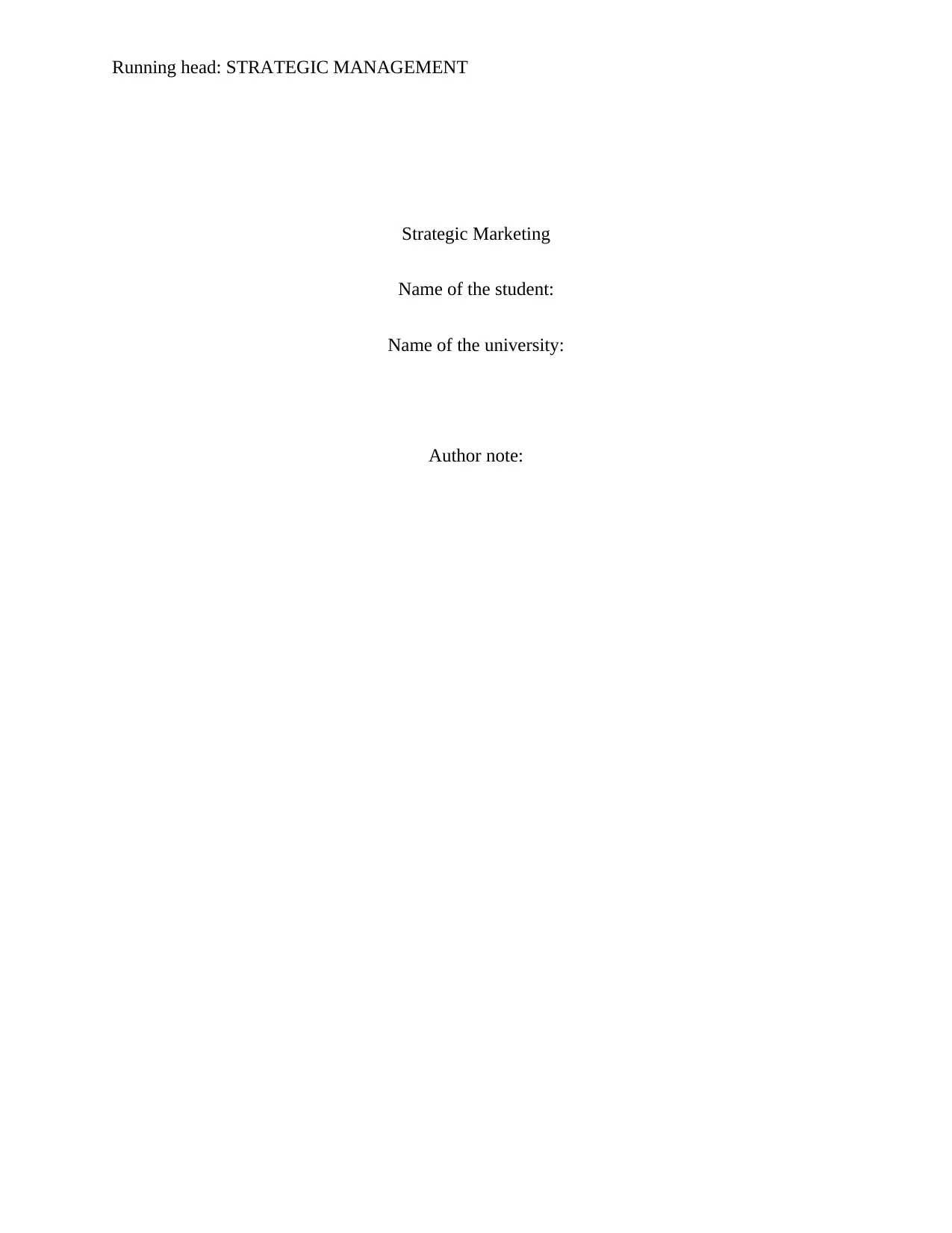
Running head: STRATEGIC MANAGEMENT
Strategic Marketing
Name of the student:
Name of the university:
Author note:
Strategic Marketing
Name of the student:
Name of the university:
Author note:
Secure Best Marks with AI Grader
Need help grading? Try our AI Grader for instant feedback on your assignments.
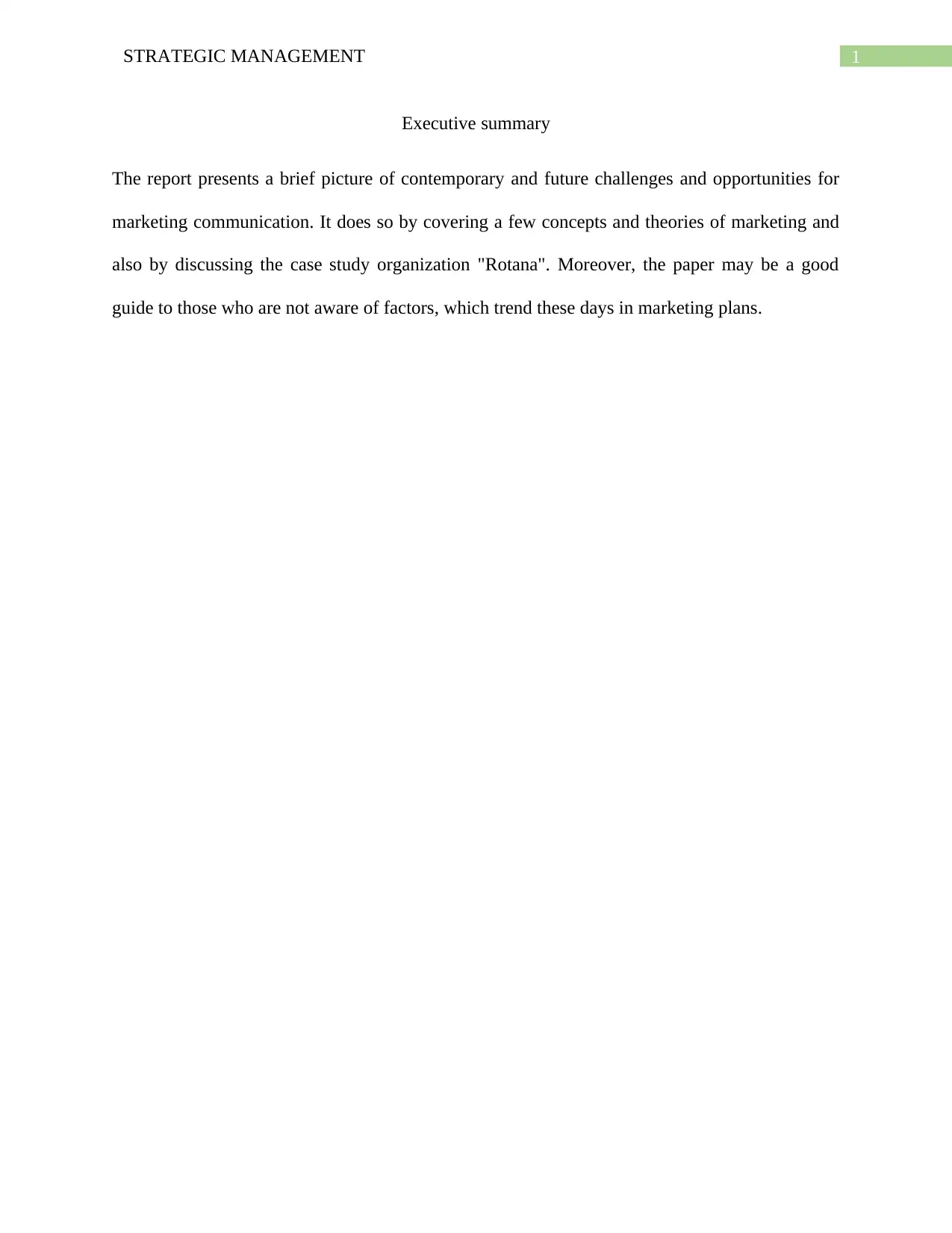
1STRATEGIC MANAGEMENT
Executive summary
The report presents a brief picture of contemporary and future challenges and opportunities for
marketing communication. It does so by covering a few concepts and theories of marketing and
also by discussing the case study organization "Rotana". Moreover, the paper may be a good
guide to those who are not aware of factors, which trend these days in marketing plans.
Executive summary
The report presents a brief picture of contemporary and future challenges and opportunities for
marketing communication. It does so by covering a few concepts and theories of marketing and
also by discussing the case study organization "Rotana". Moreover, the paper may be a good
guide to those who are not aware of factors, which trend these days in marketing plans.
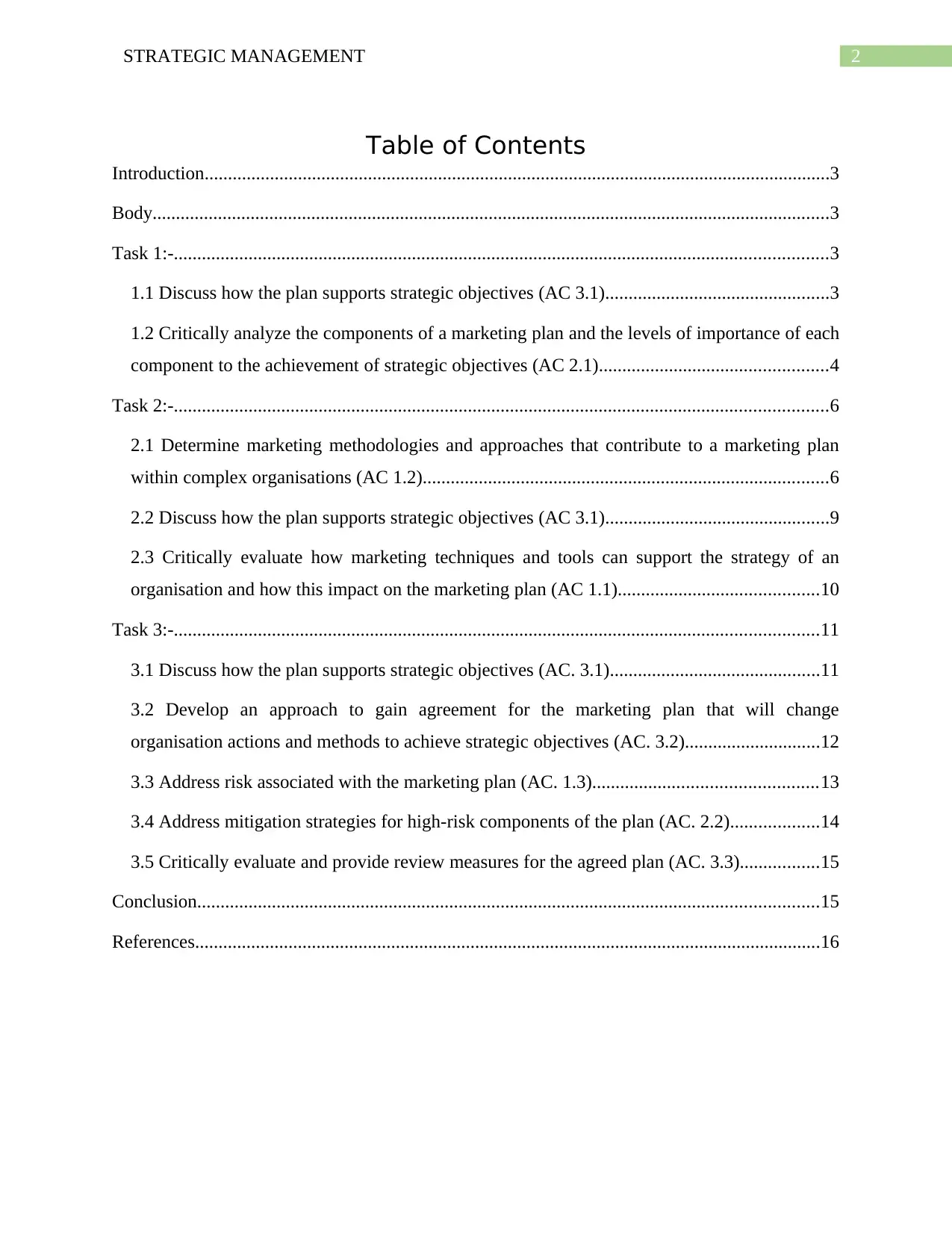
2STRATEGIC MANAGEMENT
Table of Contents
Introduction......................................................................................................................................3
Body.................................................................................................................................................3
Task 1:-............................................................................................................................................3
1.1 Discuss how the plan supports strategic objectives (AC 3.1)................................................3
1.2 Critically analyze the components of a marketing plan and the levels of importance of each
component to the achievement of strategic objectives (AC 2.1).................................................4
Task 2:-............................................................................................................................................6
2.1 Determine marketing methodologies and approaches that contribute to a marketing plan
within complex organisations (AC 1.2).......................................................................................6
2.2 Discuss how the plan supports strategic objectives (AC 3.1)................................................9
2.3 Critically evaluate how marketing techniques and tools can support the strategy of an
organisation and how this impact on the marketing plan (AC 1.1)...........................................10
Task 3:-..........................................................................................................................................11
3.1 Discuss how the plan supports strategic objectives (AC. 3.1).............................................11
3.2 Develop an approach to gain agreement for the marketing plan that will change
organisation actions and methods to achieve strategic objectives (AC. 3.2).............................12
3.3 Address risk associated with the marketing plan (AC. 1.3)................................................13
3.4 Address mitigation strategies for high-risk components of the plan (AC. 2.2)...................14
3.5 Critically evaluate and provide review measures for the agreed plan (AC. 3.3).................15
Conclusion.....................................................................................................................................15
References......................................................................................................................................16
Table of Contents
Introduction......................................................................................................................................3
Body.................................................................................................................................................3
Task 1:-............................................................................................................................................3
1.1 Discuss how the plan supports strategic objectives (AC 3.1)................................................3
1.2 Critically analyze the components of a marketing plan and the levels of importance of each
component to the achievement of strategic objectives (AC 2.1).................................................4
Task 2:-............................................................................................................................................6
2.1 Determine marketing methodologies and approaches that contribute to a marketing plan
within complex organisations (AC 1.2).......................................................................................6
2.2 Discuss how the plan supports strategic objectives (AC 3.1)................................................9
2.3 Critically evaluate how marketing techniques and tools can support the strategy of an
organisation and how this impact on the marketing plan (AC 1.1)...........................................10
Task 3:-..........................................................................................................................................11
3.1 Discuss how the plan supports strategic objectives (AC. 3.1).............................................11
3.2 Develop an approach to gain agreement for the marketing plan that will change
organisation actions and methods to achieve strategic objectives (AC. 3.2).............................12
3.3 Address risk associated with the marketing plan (AC. 1.3)................................................13
3.4 Address mitigation strategies for high-risk components of the plan (AC. 2.2)...................14
3.5 Critically evaluate and provide review measures for the agreed plan (AC. 3.3).................15
Conclusion.....................................................................................................................................15
References......................................................................................................................................16
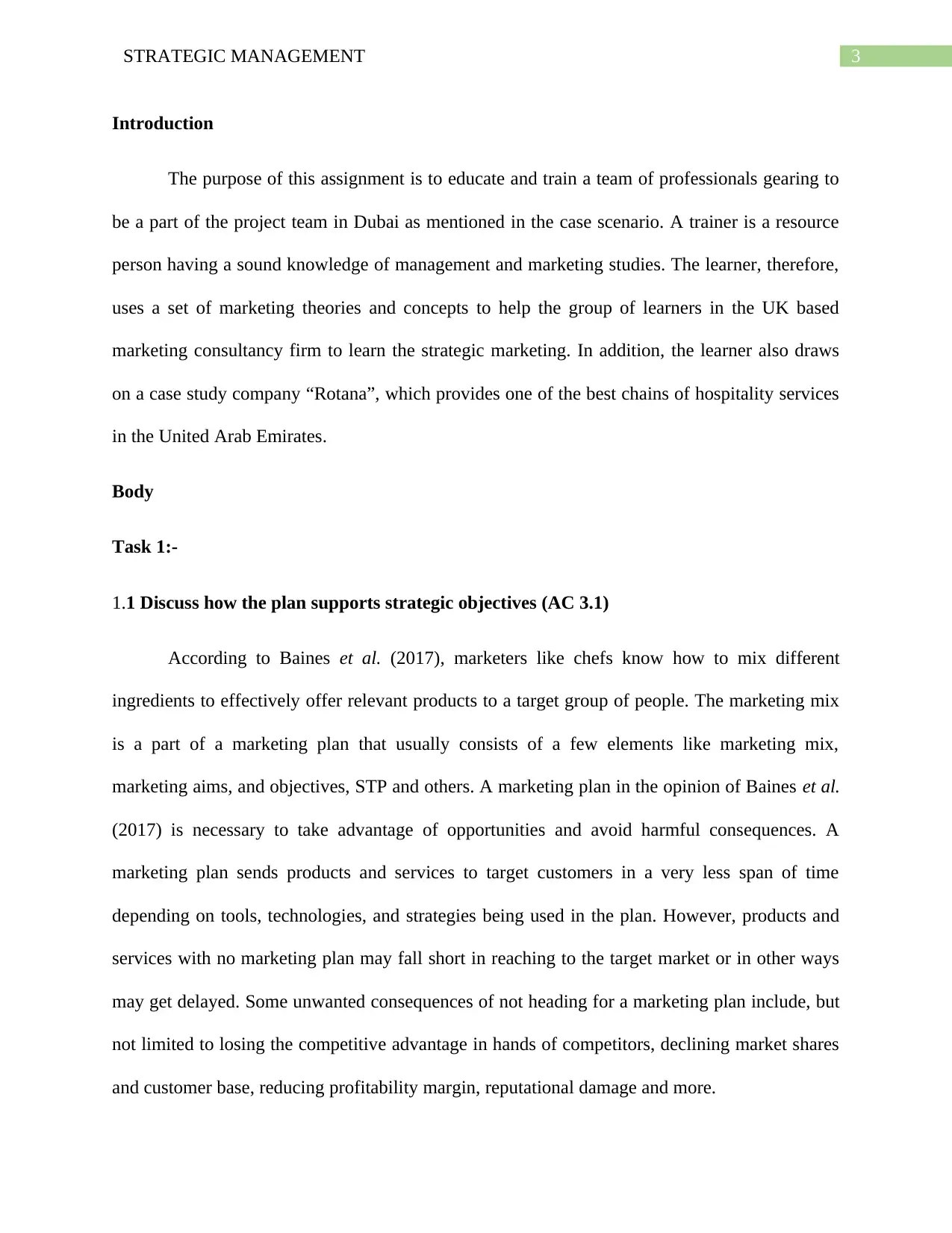
3STRATEGIC MANAGEMENT
Introduction
The purpose of this assignment is to educate and train a team of professionals gearing to
be a part of the project team in Dubai as mentioned in the case scenario. A trainer is a resource
person having a sound knowledge of management and marketing studies. The learner, therefore,
uses a set of marketing theories and concepts to help the group of learners in the UK based
marketing consultancy firm to learn the strategic marketing. In addition, the learner also draws
on a case study company “Rotana”, which provides one of the best chains of hospitality services
in the United Arab Emirates.
Body
Task 1:-
1.1 Discuss how the plan supports strategic objectives (AC 3.1)
According to Baines et al. (2017), marketers like chefs know how to mix different
ingredients to effectively offer relevant products to a target group of people. The marketing mix
is a part of a marketing plan that usually consists of a few elements like marketing mix,
marketing aims, and objectives, STP and others. A marketing plan in the opinion of Baines et al.
(2017) is necessary to take advantage of opportunities and avoid harmful consequences. A
marketing plan sends products and services to target customers in a very less span of time
depending on tools, technologies, and strategies being used in the plan. However, products and
services with no marketing plan may fall short in reaching to the target market or in other ways
may get delayed. Some unwanted consequences of not heading for a marketing plan include, but
not limited to losing the competitive advantage in hands of competitors, declining market shares
and customer base, reducing profitability margin, reputational damage and more.
Introduction
The purpose of this assignment is to educate and train a team of professionals gearing to
be a part of the project team in Dubai as mentioned in the case scenario. A trainer is a resource
person having a sound knowledge of management and marketing studies. The learner, therefore,
uses a set of marketing theories and concepts to help the group of learners in the UK based
marketing consultancy firm to learn the strategic marketing. In addition, the learner also draws
on a case study company “Rotana”, which provides one of the best chains of hospitality services
in the United Arab Emirates.
Body
Task 1:-
1.1 Discuss how the plan supports strategic objectives (AC 3.1)
According to Baines et al. (2017), marketers like chefs know how to mix different
ingredients to effectively offer relevant products to a target group of people. The marketing mix
is a part of a marketing plan that usually consists of a few elements like marketing mix,
marketing aims, and objectives, STP and others. A marketing plan in the opinion of Baines et al.
(2017) is necessary to take advantage of opportunities and avoid harmful consequences. A
marketing plan sends products and services to target customers in a very less span of time
depending on tools, technologies, and strategies being used in the plan. However, products and
services with no marketing plan may fall short in reaching to the target market or in other ways
may get delayed. Some unwanted consequences of not heading for a marketing plan include, but
not limited to losing the competitive advantage in hands of competitors, declining market shares
and customer base, reducing profitability margin, reputational damage and more.
Paraphrase This Document
Need a fresh take? Get an instant paraphrase of this document with our AI Paraphraser
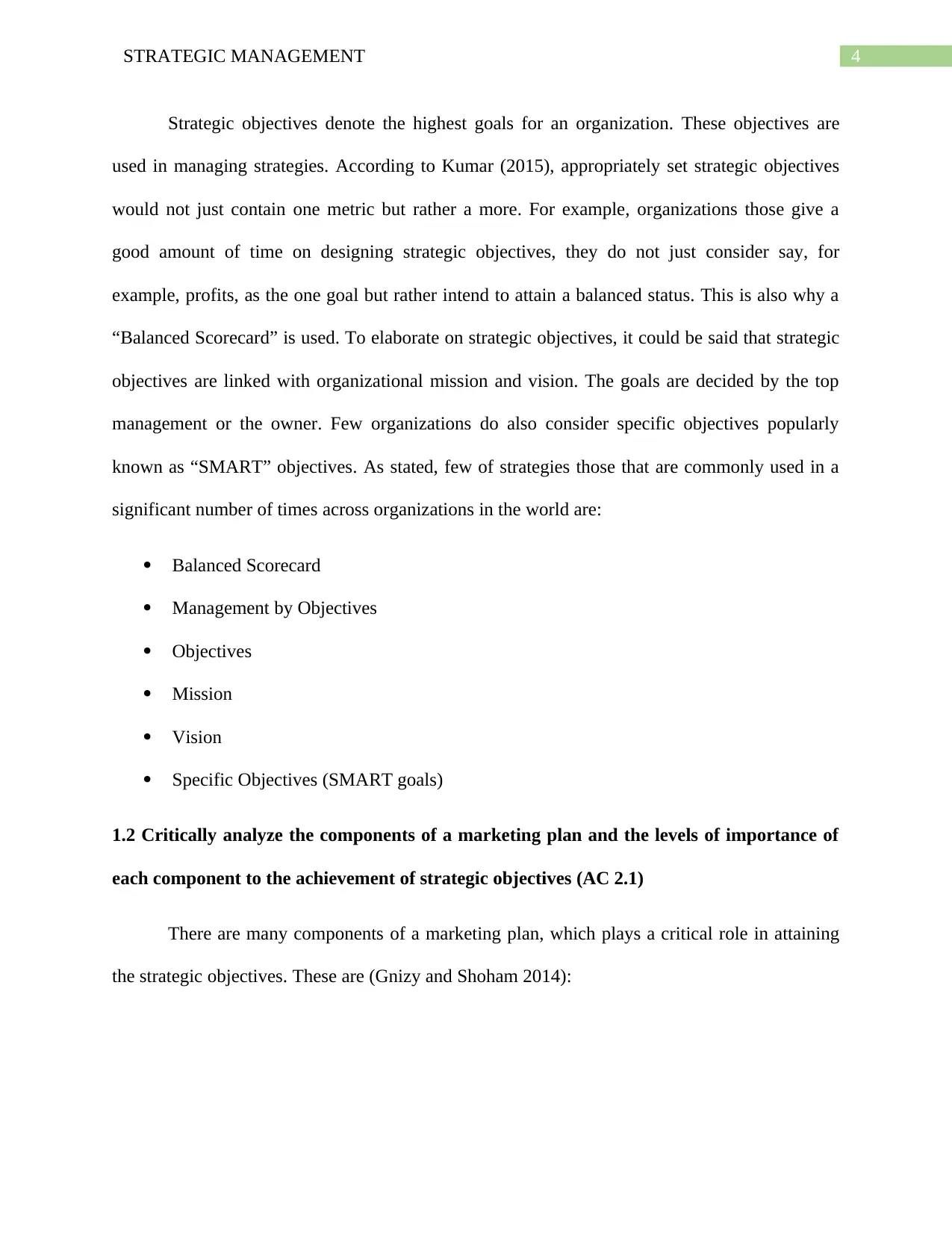
4STRATEGIC MANAGEMENT
Strategic objectives denote the highest goals for an organization. These objectives are
used in managing strategies. According to Kumar (2015), appropriately set strategic objectives
would not just contain one metric but rather a more. For example, organizations those give a
good amount of time on designing strategic objectives, they do not just consider say, for
example, profits, as the one goal but rather intend to attain a balanced status. This is also why a
“Balanced Scorecard” is used. To elaborate on strategic objectives, it could be said that strategic
objectives are linked with organizational mission and vision. The goals are decided by the top
management or the owner. Few organizations do also consider specific objectives popularly
known as “SMART” objectives. As stated, few of strategies those that are commonly used in a
significant number of times across organizations in the world are:
Balanced Scorecard
Management by Objectives
Objectives
Mission
Vision
Specific Objectives (SMART goals)
1.2 Critically analyze the components of a marketing plan and the levels of importance of
each component to the achievement of strategic objectives (AC 2.1)
There are many components of a marketing plan, which plays a critical role in attaining
the strategic objectives. These are (Gnizy and Shoham 2014):
Strategic objectives denote the highest goals for an organization. These objectives are
used in managing strategies. According to Kumar (2015), appropriately set strategic objectives
would not just contain one metric but rather a more. For example, organizations those give a
good amount of time on designing strategic objectives, they do not just consider say, for
example, profits, as the one goal but rather intend to attain a balanced status. This is also why a
“Balanced Scorecard” is used. To elaborate on strategic objectives, it could be said that strategic
objectives are linked with organizational mission and vision. The goals are decided by the top
management or the owner. Few organizations do also consider specific objectives popularly
known as “SMART” objectives. As stated, few of strategies those that are commonly used in a
significant number of times across organizations in the world are:
Balanced Scorecard
Management by Objectives
Objectives
Mission
Vision
Specific Objectives (SMART goals)
1.2 Critically analyze the components of a marketing plan and the levels of importance of
each component to the achievement of strategic objectives (AC 2.1)
There are many components of a marketing plan, which plays a critical role in attaining
the strategic objectives. These are (Gnizy and Shoham 2014):
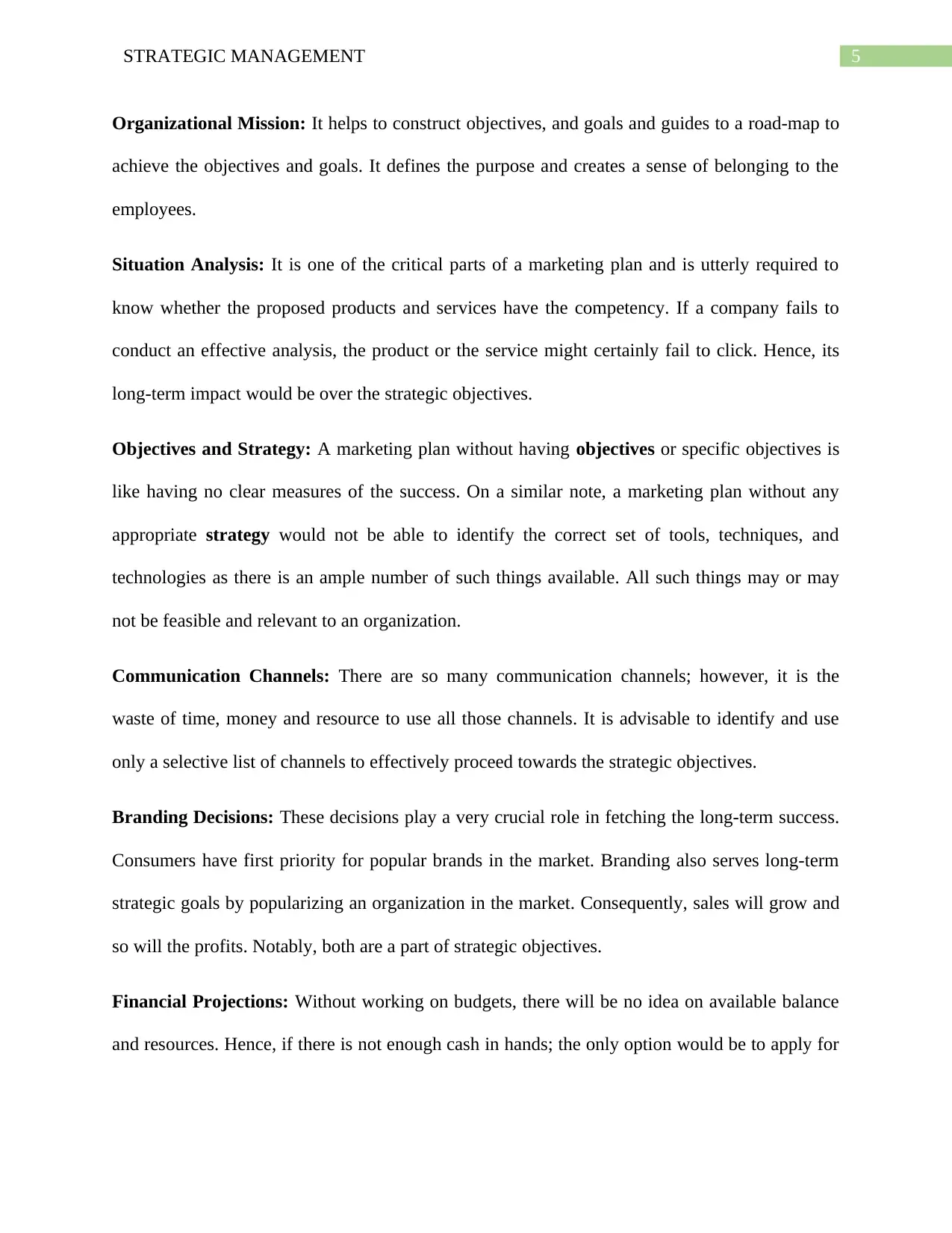
5STRATEGIC MANAGEMENT
Organizational Mission: It helps to construct objectives, and goals and guides to a road-map to
achieve the objectives and goals. It defines the purpose and creates a sense of belonging to the
employees.
Situation Analysis: It is one of the critical parts of a marketing plan and is utterly required to
know whether the proposed products and services have the competency. If a company fails to
conduct an effective analysis, the product or the service might certainly fail to click. Hence, its
long-term impact would be over the strategic objectives.
Objectives and Strategy: A marketing plan without having objectives or specific objectives is
like having no clear measures of the success. On a similar note, a marketing plan without any
appropriate strategy would not be able to identify the correct set of tools, techniques, and
technologies as there is an ample number of such things available. All such things may or may
not be feasible and relevant to an organization.
Communication Channels: There are so many communication channels; however, it is the
waste of time, money and resource to use all those channels. It is advisable to identify and use
only a selective list of channels to effectively proceed towards the strategic objectives.
Branding Decisions: These decisions play a very crucial role in fetching the long-term success.
Consumers have first priority for popular brands in the market. Branding also serves long-term
strategic goals by popularizing an organization in the market. Consequently, sales will grow and
so will the profits. Notably, both are a part of strategic objectives.
Financial Projections: Without working on budgets, there will be no idea on available balance
and resources. Hence, if there is not enough cash in hands; the only option would be to apply for
Organizational Mission: It helps to construct objectives, and goals and guides to a road-map to
achieve the objectives and goals. It defines the purpose and creates a sense of belonging to the
employees.
Situation Analysis: It is one of the critical parts of a marketing plan and is utterly required to
know whether the proposed products and services have the competency. If a company fails to
conduct an effective analysis, the product or the service might certainly fail to click. Hence, its
long-term impact would be over the strategic objectives.
Objectives and Strategy: A marketing plan without having objectives or specific objectives is
like having no clear measures of the success. On a similar note, a marketing plan without any
appropriate strategy would not be able to identify the correct set of tools, techniques, and
technologies as there is an ample number of such things available. All such things may or may
not be feasible and relevant to an organization.
Communication Channels: There are so many communication channels; however, it is the
waste of time, money and resource to use all those channels. It is advisable to identify and use
only a selective list of channels to effectively proceed towards the strategic objectives.
Branding Decisions: These decisions play a very crucial role in fetching the long-term success.
Consumers have first priority for popular brands in the market. Branding also serves long-term
strategic goals by popularizing an organization in the market. Consequently, sales will grow and
so will the profits. Notably, both are a part of strategic objectives.
Financial Projections: Without working on budgets, there will be no idea on available balance
and resources. Hence, if there is not enough cash in hands; the only option would be to apply for
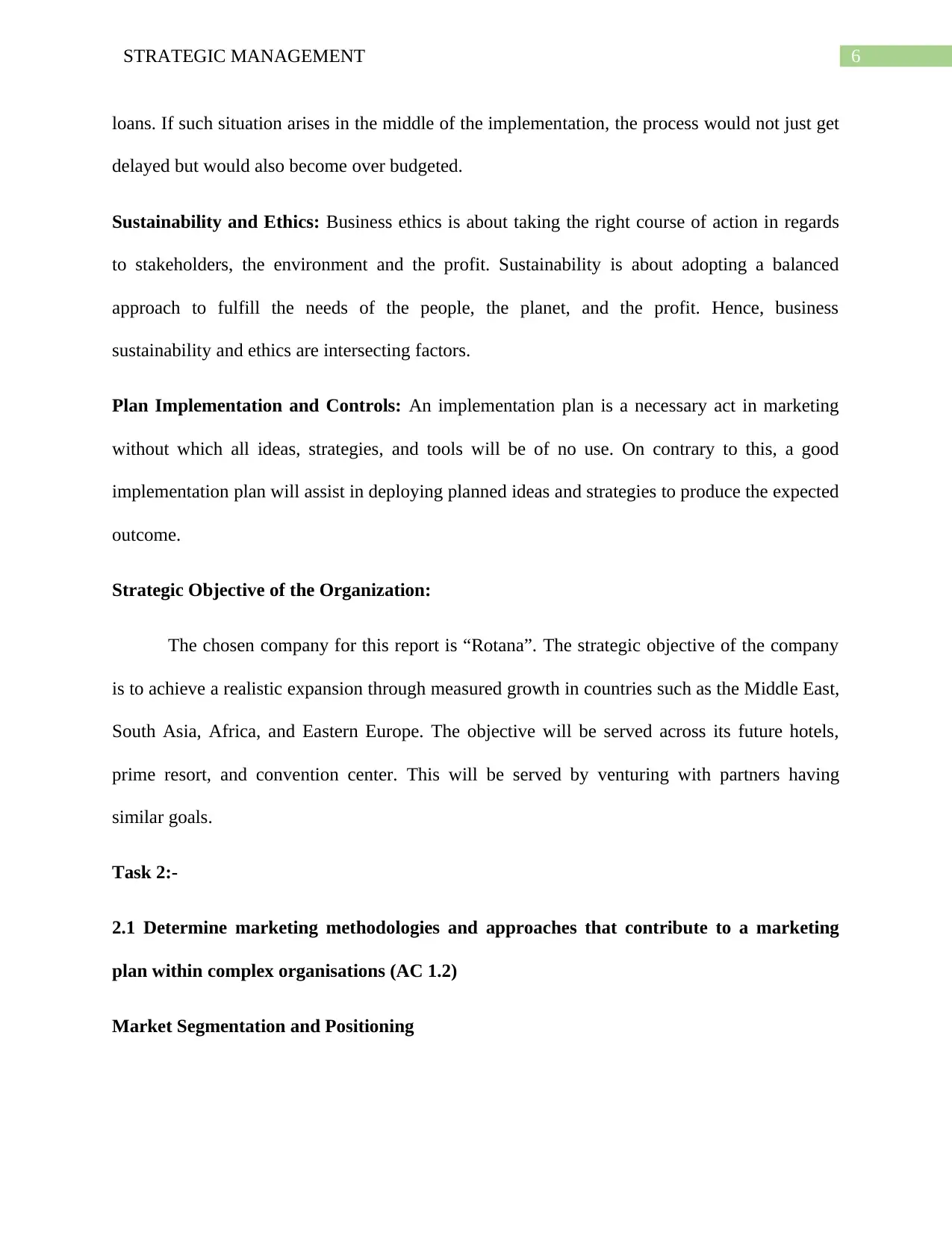
6STRATEGIC MANAGEMENT
loans. If such situation arises in the middle of the implementation, the process would not just get
delayed but would also become over budgeted.
Sustainability and Ethics: Business ethics is about taking the right course of action in regards
to stakeholders, the environment and the profit. Sustainability is about adopting a balanced
approach to fulfill the needs of the people, the planet, and the profit. Hence, business
sustainability and ethics are intersecting factors.
Plan Implementation and Controls: An implementation plan is a necessary act in marketing
without which all ideas, strategies, and tools will be of no use. On contrary to this, a good
implementation plan will assist in deploying planned ideas and strategies to produce the expected
outcome.
Strategic Objective of the Organization:
The chosen company for this report is “Rotana”. The strategic objective of the company
is to achieve a realistic expansion through measured growth in countries such as the Middle East,
South Asia, Africa, and Eastern Europe. The objective will be served across its future hotels,
prime resort, and convention center. This will be served by venturing with partners having
similar goals.
Task 2:-
2.1 Determine marketing methodologies and approaches that contribute to a marketing
plan within complex organisations (AC 1.2)
Market Segmentation and Positioning
loans. If such situation arises in the middle of the implementation, the process would not just get
delayed but would also become over budgeted.
Sustainability and Ethics: Business ethics is about taking the right course of action in regards
to stakeholders, the environment and the profit. Sustainability is about adopting a balanced
approach to fulfill the needs of the people, the planet, and the profit. Hence, business
sustainability and ethics are intersecting factors.
Plan Implementation and Controls: An implementation plan is a necessary act in marketing
without which all ideas, strategies, and tools will be of no use. On contrary to this, a good
implementation plan will assist in deploying planned ideas and strategies to produce the expected
outcome.
Strategic Objective of the Organization:
The chosen company for this report is “Rotana”. The strategic objective of the company
is to achieve a realistic expansion through measured growth in countries such as the Middle East,
South Asia, Africa, and Eastern Europe. The objective will be served across its future hotels,
prime resort, and convention center. This will be served by venturing with partners having
similar goals.
Task 2:-
2.1 Determine marketing methodologies and approaches that contribute to a marketing
plan within complex organisations (AC 1.2)
Market Segmentation and Positioning
Secure Best Marks with AI Grader
Need help grading? Try our AI Grader for instant feedback on your assignments.
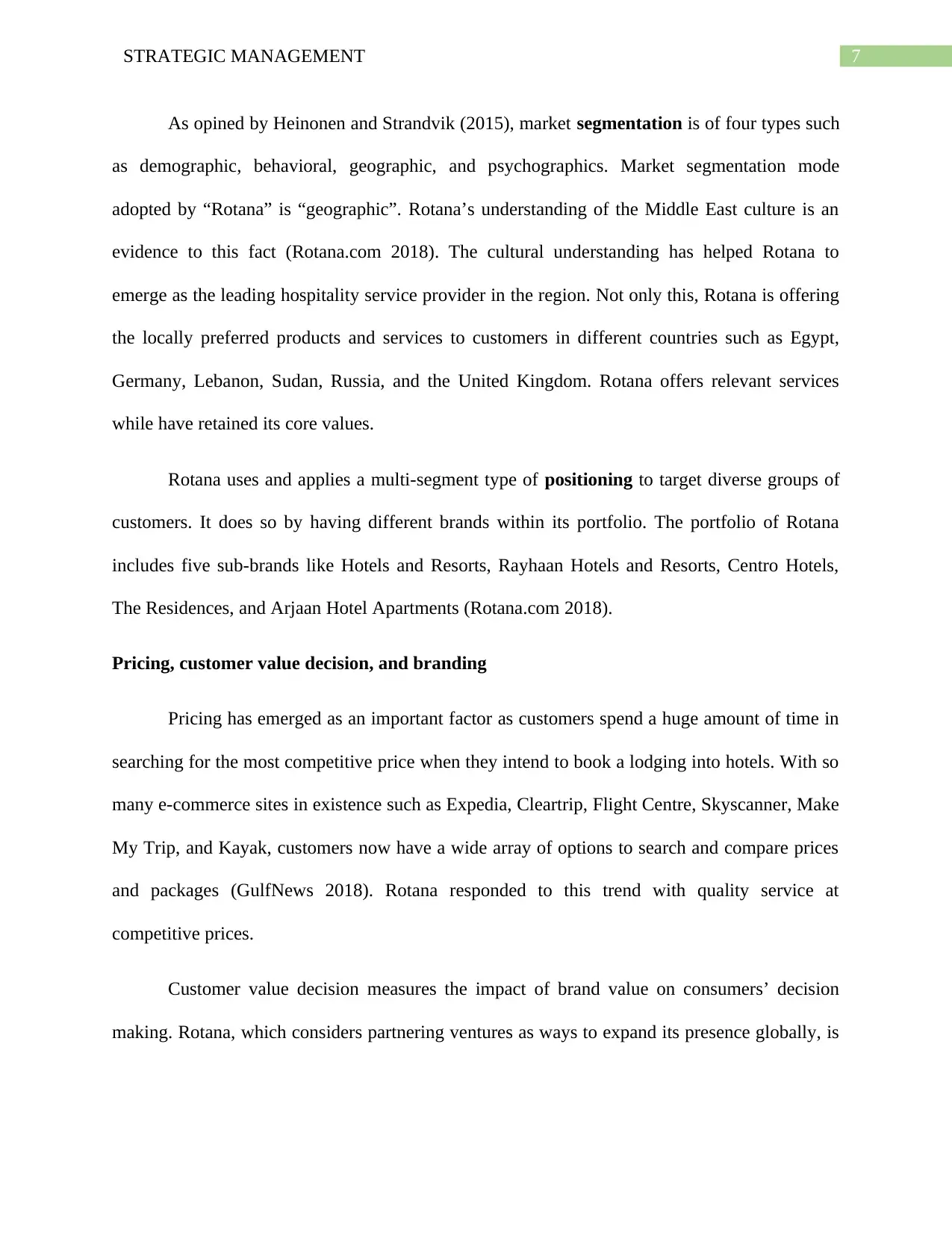
7STRATEGIC MANAGEMENT
As opined by Heinonen and Strandvik (2015), market segmentation is of four types such
as demographic, behavioral, geographic, and psychographics. Market segmentation mode
adopted by “Rotana” is “geographic”. Rotana’s understanding of the Middle East culture is an
evidence to this fact (Rotana.com 2018). The cultural understanding has helped Rotana to
emerge as the leading hospitality service provider in the region. Not only this, Rotana is offering
the locally preferred products and services to customers in different countries such as Egypt,
Germany, Lebanon, Sudan, Russia, and the United Kingdom. Rotana offers relevant services
while have retained its core values.
Rotana uses and applies a multi-segment type of positioning to target diverse groups of
customers. It does so by having different brands within its portfolio. The portfolio of Rotana
includes five sub-brands like Hotels and Resorts, Rayhaan Hotels and Resorts, Centro Hotels,
The Residences, and Arjaan Hotel Apartments (Rotana.com 2018).
Pricing, customer value decision, and branding
Pricing has emerged as an important factor as customers spend a huge amount of time in
searching for the most competitive price when they intend to book a lodging into hotels. With so
many e-commerce sites in existence such as Expedia, Cleartrip, Flight Centre, Skyscanner, Make
My Trip, and Kayak, customers now have a wide array of options to search and compare prices
and packages (GulfNews 2018). Rotana responded to this trend with quality service at
competitive prices.
Customer value decision measures the impact of brand value on consumers’ decision
making. Rotana, which considers partnering ventures as ways to expand its presence globally, is
As opined by Heinonen and Strandvik (2015), market segmentation is of four types such
as demographic, behavioral, geographic, and psychographics. Market segmentation mode
adopted by “Rotana” is “geographic”. Rotana’s understanding of the Middle East culture is an
evidence to this fact (Rotana.com 2018). The cultural understanding has helped Rotana to
emerge as the leading hospitality service provider in the region. Not only this, Rotana is offering
the locally preferred products and services to customers in different countries such as Egypt,
Germany, Lebanon, Sudan, Russia, and the United Kingdom. Rotana offers relevant services
while have retained its core values.
Rotana uses and applies a multi-segment type of positioning to target diverse groups of
customers. It does so by having different brands within its portfolio. The portfolio of Rotana
includes five sub-brands like Hotels and Resorts, Rayhaan Hotels and Resorts, Centro Hotels,
The Residences, and Arjaan Hotel Apartments (Rotana.com 2018).
Pricing, customer value decision, and branding
Pricing has emerged as an important factor as customers spend a huge amount of time in
searching for the most competitive price when they intend to book a lodging into hotels. With so
many e-commerce sites in existence such as Expedia, Cleartrip, Flight Centre, Skyscanner, Make
My Trip, and Kayak, customers now have a wide array of options to search and compare prices
and packages (GulfNews 2018). Rotana responded to this trend with quality service at
competitive prices.
Customer value decision measures the impact of brand value on consumers’ decision
making. Rotana, which considers partnering ventures as ways to expand its presence globally, is
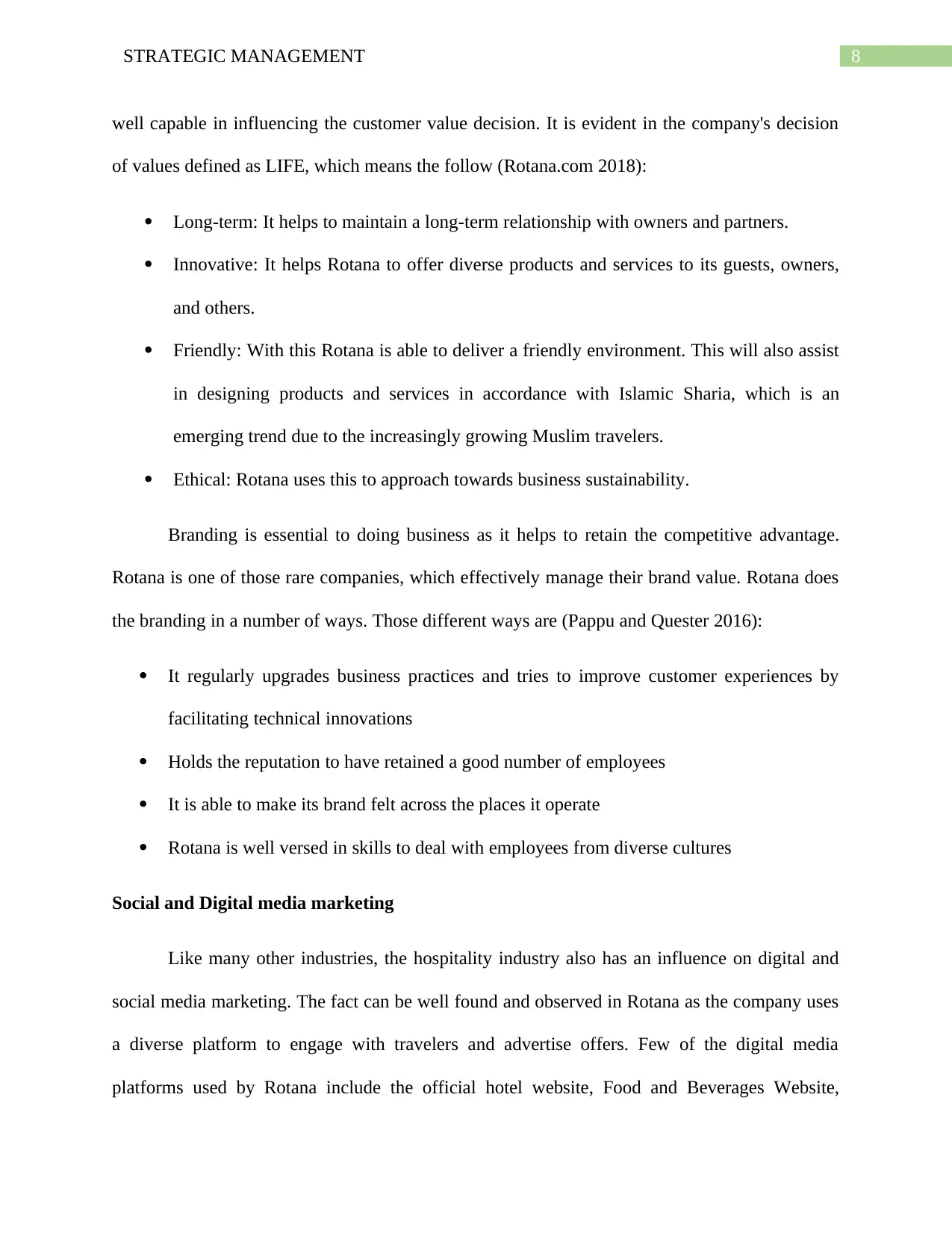
8STRATEGIC MANAGEMENT
well capable in influencing the customer value decision. It is evident in the company's decision
of values defined as LIFE, which means the follow (Rotana.com 2018):
Long-term: It helps to maintain a long-term relationship with owners and partners.
Innovative: It helps Rotana to offer diverse products and services to its guests, owners,
and others.
Friendly: With this Rotana is able to deliver a friendly environment. This will also assist
in designing products and services in accordance with Islamic Sharia, which is an
emerging trend due to the increasingly growing Muslim travelers.
Ethical: Rotana uses this to approach towards business sustainability.
Branding is essential to doing business as it helps to retain the competitive advantage.
Rotana is one of those rare companies, which effectively manage their brand value. Rotana does
the branding in a number of ways. Those different ways are (Pappu and Quester 2016):
It regularly upgrades business practices and tries to improve customer experiences by
facilitating technical innovations
Holds the reputation to have retained a good number of employees
It is able to make its brand felt across the places it operate
Rotana is well versed in skills to deal with employees from diverse cultures
Social and Digital media marketing
Like many other industries, the hospitality industry also has an influence on digital and
social media marketing. The fact can be well found and observed in Rotana as the company uses
a diverse platform to engage with travelers and advertise offers. Few of the digital media
platforms used by Rotana include the official hotel website, Food and Beverages Website,
well capable in influencing the customer value decision. It is evident in the company's decision
of values defined as LIFE, which means the follow (Rotana.com 2018):
Long-term: It helps to maintain a long-term relationship with owners and partners.
Innovative: It helps Rotana to offer diverse products and services to its guests, owners,
and others.
Friendly: With this Rotana is able to deliver a friendly environment. This will also assist
in designing products and services in accordance with Islamic Sharia, which is an
emerging trend due to the increasingly growing Muslim travelers.
Ethical: Rotana uses this to approach towards business sustainability.
Branding is essential to doing business as it helps to retain the competitive advantage.
Rotana is one of those rare companies, which effectively manage their brand value. Rotana does
the branding in a number of ways. Those different ways are (Pappu and Quester 2016):
It regularly upgrades business practices and tries to improve customer experiences by
facilitating technical innovations
Holds the reputation to have retained a good number of employees
It is able to make its brand felt across the places it operate
Rotana is well versed in skills to deal with employees from diverse cultures
Social and Digital media marketing
Like many other industries, the hospitality industry also has an influence on digital and
social media marketing. The fact can be well found and observed in Rotana as the company uses
a diverse platform to engage with travelers and advertise offers. Few of the digital media
platforms used by Rotana include the official hotel website, Food and Beverages Website,
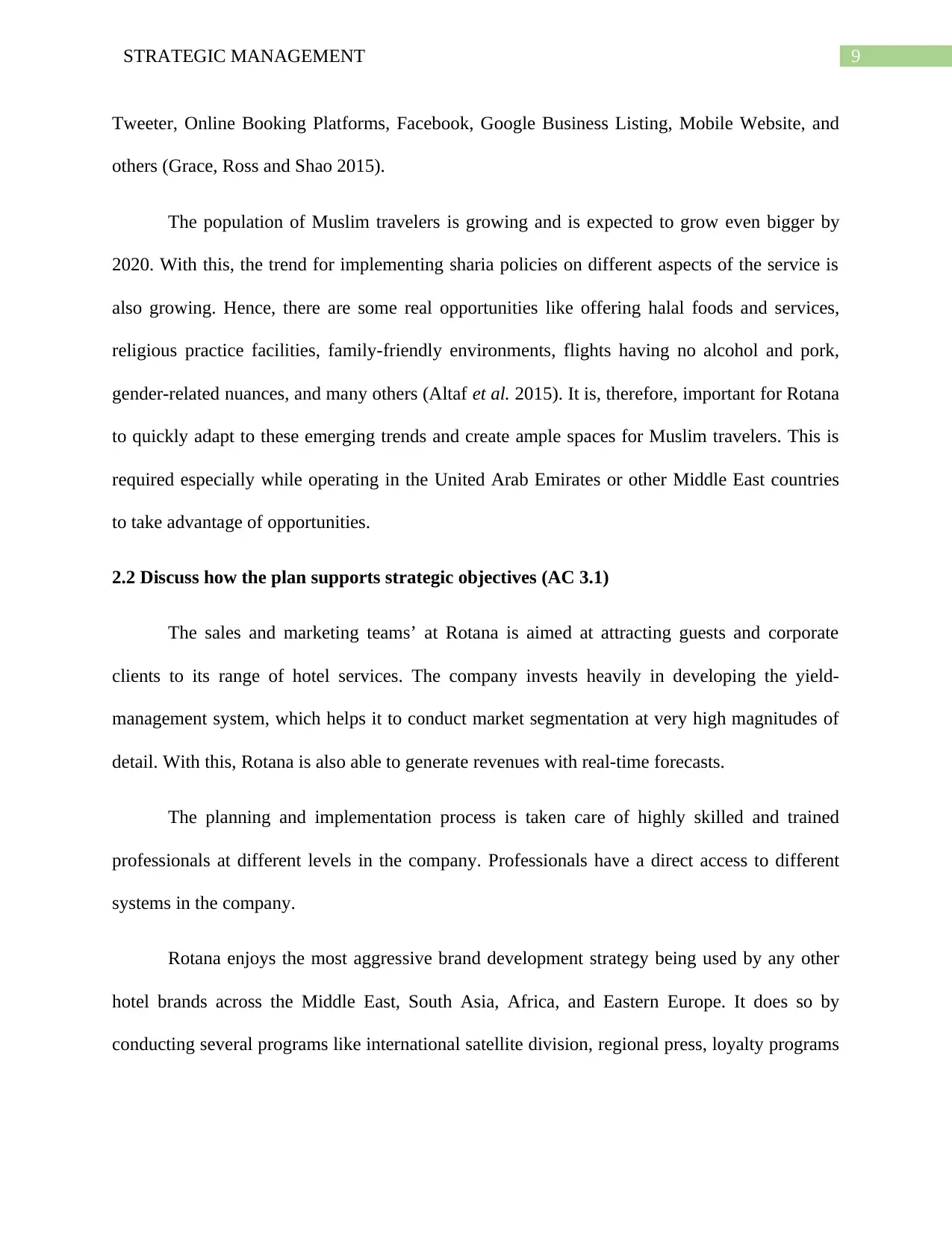
9STRATEGIC MANAGEMENT
Tweeter, Online Booking Platforms, Facebook, Google Business Listing, Mobile Website, and
others (Grace, Ross and Shao 2015).
The population of Muslim travelers is growing and is expected to grow even bigger by
2020. With this, the trend for implementing sharia policies on different aspects of the service is
also growing. Hence, there are some real opportunities like offering halal foods and services,
religious practice facilities, family-friendly environments, flights having no alcohol and pork,
gender-related nuances, and many others (Altaf et al. 2015). It is, therefore, important for Rotana
to quickly adapt to these emerging trends and create ample spaces for Muslim travelers. This is
required especially while operating in the United Arab Emirates or other Middle East countries
to take advantage of opportunities.
2.2 Discuss how the plan supports strategic objectives (AC 3.1)
The sales and marketing teams’ at Rotana is aimed at attracting guests and corporate
clients to its range of hotel services. The company invests heavily in developing the yield-
management system, which helps it to conduct market segmentation at very high magnitudes of
detail. With this, Rotana is also able to generate revenues with real-time forecasts.
The planning and implementation process is taken care of highly skilled and trained
professionals at different levels in the company. Professionals have a direct access to different
systems in the company.
Rotana enjoys the most aggressive brand development strategy being used by any other
hotel brands across the Middle East, South Asia, Africa, and Eastern Europe. It does so by
conducting several programs like international satellite division, regional press, loyalty programs
Tweeter, Online Booking Platforms, Facebook, Google Business Listing, Mobile Website, and
others (Grace, Ross and Shao 2015).
The population of Muslim travelers is growing and is expected to grow even bigger by
2020. With this, the trend for implementing sharia policies on different aspects of the service is
also growing. Hence, there are some real opportunities like offering halal foods and services,
religious practice facilities, family-friendly environments, flights having no alcohol and pork,
gender-related nuances, and many others (Altaf et al. 2015). It is, therefore, important for Rotana
to quickly adapt to these emerging trends and create ample spaces for Muslim travelers. This is
required especially while operating in the United Arab Emirates or other Middle East countries
to take advantage of opportunities.
2.2 Discuss how the plan supports strategic objectives (AC 3.1)
The sales and marketing teams’ at Rotana is aimed at attracting guests and corporate
clients to its range of hotel services. The company invests heavily in developing the yield-
management system, which helps it to conduct market segmentation at very high magnitudes of
detail. With this, Rotana is also able to generate revenues with real-time forecasts.
The planning and implementation process is taken care of highly skilled and trained
professionals at different levels in the company. Professionals have a direct access to different
systems in the company.
Rotana enjoys the most aggressive brand development strategy being used by any other
hotel brands across the Middle East, South Asia, Africa, and Eastern Europe. It does so by
conducting several programs like international satellite division, regional press, loyalty programs
Paraphrase This Document
Need a fresh take? Get an instant paraphrase of this document with our AI Paraphraser
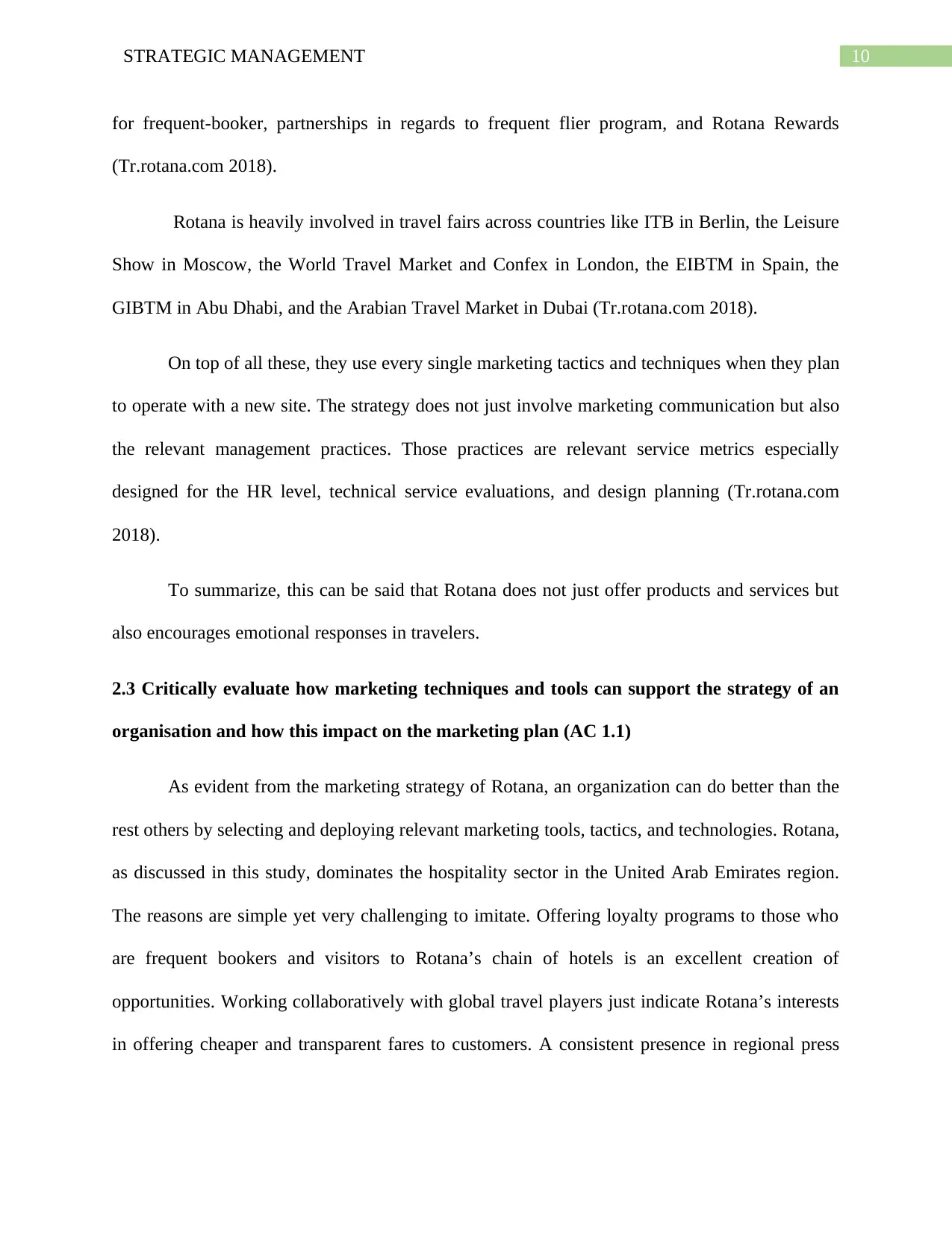
10STRATEGIC MANAGEMENT
for frequent-booker, partnerships in regards to frequent flier program, and Rotana Rewards
(Tr.rotana.com 2018).
Rotana is heavily involved in travel fairs across countries like ITB in Berlin, the Leisure
Show in Moscow, the World Travel Market and Confex in London, the EIBTM in Spain, the
GIBTM in Abu Dhabi, and the Arabian Travel Market in Dubai (Tr.rotana.com 2018).
On top of all these, they use every single marketing tactics and techniques when they plan
to operate with a new site. The strategy does not just involve marketing communication but also
the relevant management practices. Those practices are relevant service metrics especially
designed for the HR level, technical service evaluations, and design planning (Tr.rotana.com
2018).
To summarize, this can be said that Rotana does not just offer products and services but
also encourages emotional responses in travelers.
2.3 Critically evaluate how marketing techniques and tools can support the strategy of an
organisation and how this impact on the marketing plan (AC 1.1)
As evident from the marketing strategy of Rotana, an organization can do better than the
rest others by selecting and deploying relevant marketing tools, tactics, and technologies. Rotana,
as discussed in this study, dominates the hospitality sector in the United Arab Emirates region.
The reasons are simple yet very challenging to imitate. Offering loyalty programs to those who
are frequent bookers and visitors to Rotana’s chain of hotels is an excellent creation of
opportunities. Working collaboratively with global travel players just indicate Rotana’s interests
in offering cheaper and transparent fares to customers. A consistent presence in regional press
for frequent-booker, partnerships in regards to frequent flier program, and Rotana Rewards
(Tr.rotana.com 2018).
Rotana is heavily involved in travel fairs across countries like ITB in Berlin, the Leisure
Show in Moscow, the World Travel Market and Confex in London, the EIBTM in Spain, the
GIBTM in Abu Dhabi, and the Arabian Travel Market in Dubai (Tr.rotana.com 2018).
On top of all these, they use every single marketing tactics and techniques when they plan
to operate with a new site. The strategy does not just involve marketing communication but also
the relevant management practices. Those practices are relevant service metrics especially
designed for the HR level, technical service evaluations, and design planning (Tr.rotana.com
2018).
To summarize, this can be said that Rotana does not just offer products and services but
also encourages emotional responses in travelers.
2.3 Critically evaluate how marketing techniques and tools can support the strategy of an
organisation and how this impact on the marketing plan (AC 1.1)
As evident from the marketing strategy of Rotana, an organization can do better than the
rest others by selecting and deploying relevant marketing tools, tactics, and technologies. Rotana,
as discussed in this study, dominates the hospitality sector in the United Arab Emirates region.
The reasons are simple yet very challenging to imitate. Offering loyalty programs to those who
are frequent bookers and visitors to Rotana’s chain of hotels is an excellent creation of
opportunities. Working collaboratively with global travel players just indicate Rotana’s interests
in offering cheaper and transparent fares to customers. A consistent presence in regional press
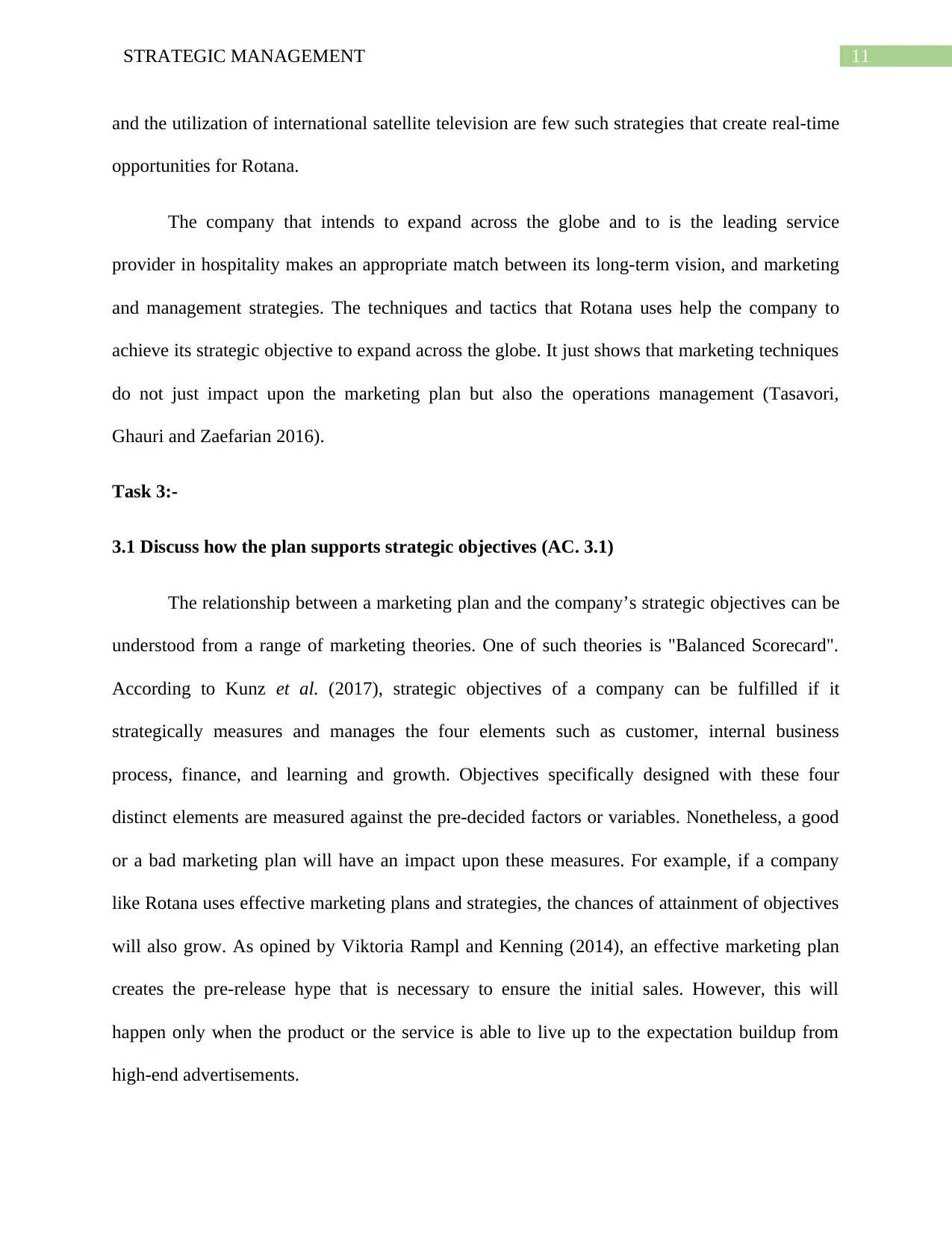
11STRATEGIC MANAGEMENT
and the utilization of international satellite television are few such strategies that create real-time
opportunities for Rotana.
The company that intends to expand across the globe and to is the leading service
provider in hospitality makes an appropriate match between its long-term vision, and marketing
and management strategies. The techniques and tactics that Rotana uses help the company to
achieve its strategic objective to expand across the globe. It just shows that marketing techniques
do not just impact upon the marketing plan but also the operations management (Tasavori,
Ghauri and Zaefarian 2016).
Task 3:-
3.1 Discuss how the plan supports strategic objectives (AC. 3.1)
The relationship between a marketing plan and the company’s strategic objectives can be
understood from a range of marketing theories. One of such theories is "Balanced Scorecard".
According to Kunz et al. (2017), strategic objectives of a company can be fulfilled if it
strategically measures and manages the four elements such as customer, internal business
process, finance, and learning and growth. Objectives specifically designed with these four
distinct elements are measured against the pre-decided factors or variables. Nonetheless, a good
or a bad marketing plan will have an impact upon these measures. For example, if a company
like Rotana uses effective marketing plans and strategies, the chances of attainment of objectives
will also grow. As opined by Viktoria Rampl and Kenning (2014), an effective marketing plan
creates the pre-release hype that is necessary to ensure the initial sales. However, this will
happen only when the product or the service is able to live up to the expectation buildup from
high-end advertisements.
and the utilization of international satellite television are few such strategies that create real-time
opportunities for Rotana.
The company that intends to expand across the globe and to is the leading service
provider in hospitality makes an appropriate match between its long-term vision, and marketing
and management strategies. The techniques and tactics that Rotana uses help the company to
achieve its strategic objective to expand across the globe. It just shows that marketing techniques
do not just impact upon the marketing plan but also the operations management (Tasavori,
Ghauri and Zaefarian 2016).
Task 3:-
3.1 Discuss how the plan supports strategic objectives (AC. 3.1)
The relationship between a marketing plan and the company’s strategic objectives can be
understood from a range of marketing theories. One of such theories is "Balanced Scorecard".
According to Kunz et al. (2017), strategic objectives of a company can be fulfilled if it
strategically measures and manages the four elements such as customer, internal business
process, finance, and learning and growth. Objectives specifically designed with these four
distinct elements are measured against the pre-decided factors or variables. Nonetheless, a good
or a bad marketing plan will have an impact upon these measures. For example, if a company
like Rotana uses effective marketing plans and strategies, the chances of attainment of objectives
will also grow. As opined by Viktoria Rampl and Kenning (2014), an effective marketing plan
creates the pre-release hype that is necessary to ensure the initial sales. However, this will
happen only when the product or the service is able to live up to the expectation buildup from
high-end advertisements.

12STRATEGIC MANAGEMENT
There is another theory namely the “Ansoff Matrix”, which also helps to understand an
evident relationship between a marketing plan and the strategic goals. The theory is divided into
four dissimilar quadrants such as market penetration, product development, market development,
and diversification (Viktoria Rampl and Kenning 2014). Market penetration encourages to
increase the volume of sales in the existing market. The end result of this would be increased
sales and so the profits provided if managed effectively. The end result makes up one of the
strategic goals. Product development means producing new products for the existing market.
This helps to increase the product portfolio and so the sales. The overall impact is also realized
upon the net profit margin. Though the dependability on a marketing plan varies with brand
value, it is still required in most cases. Market development is about entering a new market with
one of the existing products in the portfolio. A robust marketing plan is an effective weapon to
create an initial impact in all such situation. Diversification encourages to enter new markets
with new products. An effective marketing plan is an utter need for all such situations as it does
not only help to reach to the target market but to also create a pre-launch hype. A pre-launch
hype increases the probability of success (White 2015).
3.2 Develop an approach to gain agreement for the marketing plan that will change
organisation actions and methods to achieve strategic objectives (AC. 3.2)
A marketing plan as stated by De Meulenaer, Dens and De Pelsmacker (2015) requires a
backing majorly in the form of a cooperative work. The budget and everything associated with a
marketing plan requires an agreement of the top management. The necessity to apply marketing
strategies can be sensed; however, it should be feasible as well with the financial capacity of the
company. It additionally should be feasible with the physical and human resources. If a company
has limited or insufficient resources, there will be needs to accumulate these resources through
There is another theory namely the “Ansoff Matrix”, which also helps to understand an
evident relationship between a marketing plan and the strategic goals. The theory is divided into
four dissimilar quadrants such as market penetration, product development, market development,
and diversification (Viktoria Rampl and Kenning 2014). Market penetration encourages to
increase the volume of sales in the existing market. The end result of this would be increased
sales and so the profits provided if managed effectively. The end result makes up one of the
strategic goals. Product development means producing new products for the existing market.
This helps to increase the product portfolio and so the sales. The overall impact is also realized
upon the net profit margin. Though the dependability on a marketing plan varies with brand
value, it is still required in most cases. Market development is about entering a new market with
one of the existing products in the portfolio. A robust marketing plan is an effective weapon to
create an initial impact in all such situation. Diversification encourages to enter new markets
with new products. An effective marketing plan is an utter need for all such situations as it does
not only help to reach to the target market but to also create a pre-launch hype. A pre-launch
hype increases the probability of success (White 2015).
3.2 Develop an approach to gain agreement for the marketing plan that will change
organisation actions and methods to achieve strategic objectives (AC. 3.2)
A marketing plan as stated by De Meulenaer, Dens and De Pelsmacker (2015) requires a
backing majorly in the form of a cooperative work. The budget and everything associated with a
marketing plan requires an agreement of the top management. The necessity to apply marketing
strategies can be sensed; however, it should be feasible as well with the financial capacity of the
company. It additionally should be feasible with the physical and human resources. If a company
has limited or insufficient resources, there will be needs to accumulate these resources through
Secure Best Marks with AI Grader
Need help grading? Try our AI Grader for instant feedback on your assignments.
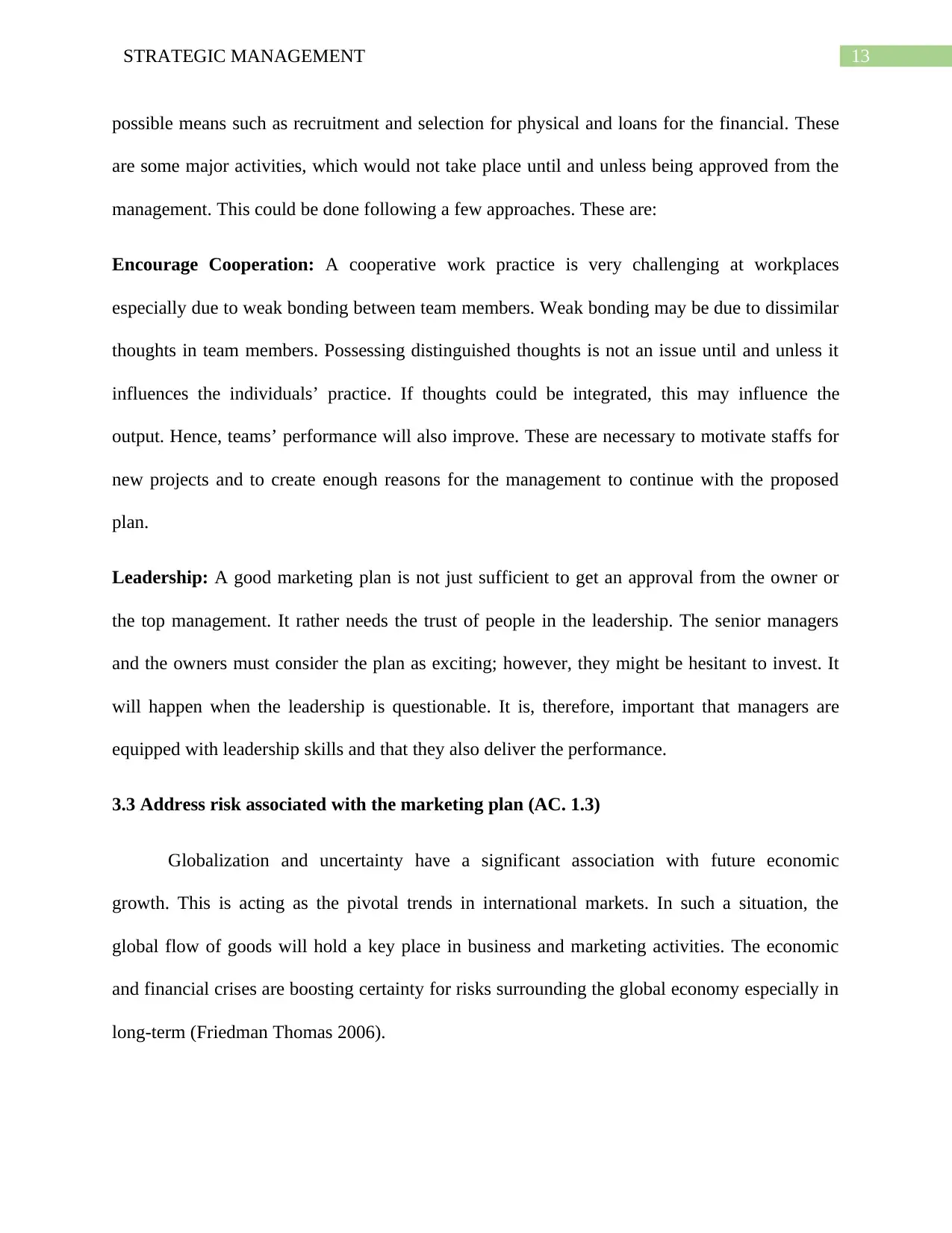
13STRATEGIC MANAGEMENT
possible means such as recruitment and selection for physical and loans for the financial. These
are some major activities, which would not take place until and unless being approved from the
management. This could be done following a few approaches. These are:
Encourage Cooperation: A cooperative work practice is very challenging at workplaces
especially due to weak bonding between team members. Weak bonding may be due to dissimilar
thoughts in team members. Possessing distinguished thoughts is not an issue until and unless it
influences the individuals’ practice. If thoughts could be integrated, this may influence the
output. Hence, teams’ performance will also improve. These are necessary to motivate staffs for
new projects and to create enough reasons for the management to continue with the proposed
plan.
Leadership: A good marketing plan is not just sufficient to get an approval from the owner or
the top management. It rather needs the trust of people in the leadership. The senior managers
and the owners must consider the plan as exciting; however, they might be hesitant to invest. It
will happen when the leadership is questionable. It is, therefore, important that managers are
equipped with leadership skills and that they also deliver the performance.
3.3 Address risk associated with the marketing plan (AC. 1.3)
Globalization and uncertainty have a significant association with future economic
growth. This is acting as the pivotal trends in international markets. In such a situation, the
global flow of goods will hold a key place in business and marketing activities. The economic
and financial crises are boosting certainty for risks surrounding the global economy especially in
long-term (Friedman Thomas 2006).
possible means such as recruitment and selection for physical and loans for the financial. These
are some major activities, which would not take place until and unless being approved from the
management. This could be done following a few approaches. These are:
Encourage Cooperation: A cooperative work practice is very challenging at workplaces
especially due to weak bonding between team members. Weak bonding may be due to dissimilar
thoughts in team members. Possessing distinguished thoughts is not an issue until and unless it
influences the individuals’ practice. If thoughts could be integrated, this may influence the
output. Hence, teams’ performance will also improve. These are necessary to motivate staffs for
new projects and to create enough reasons for the management to continue with the proposed
plan.
Leadership: A good marketing plan is not just sufficient to get an approval from the owner or
the top management. It rather needs the trust of people in the leadership. The senior managers
and the owners must consider the plan as exciting; however, they might be hesitant to invest. It
will happen when the leadership is questionable. It is, therefore, important that managers are
equipped with leadership skills and that they also deliver the performance.
3.3 Address risk associated with the marketing plan (AC. 1.3)
Globalization and uncertainty have a significant association with future economic
growth. This is acting as the pivotal trends in international markets. In such a situation, the
global flow of goods will hold a key place in business and marketing activities. The economic
and financial crises are boosting certainty for risks surrounding the global economy especially in
long-term (Friedman Thomas 2006).
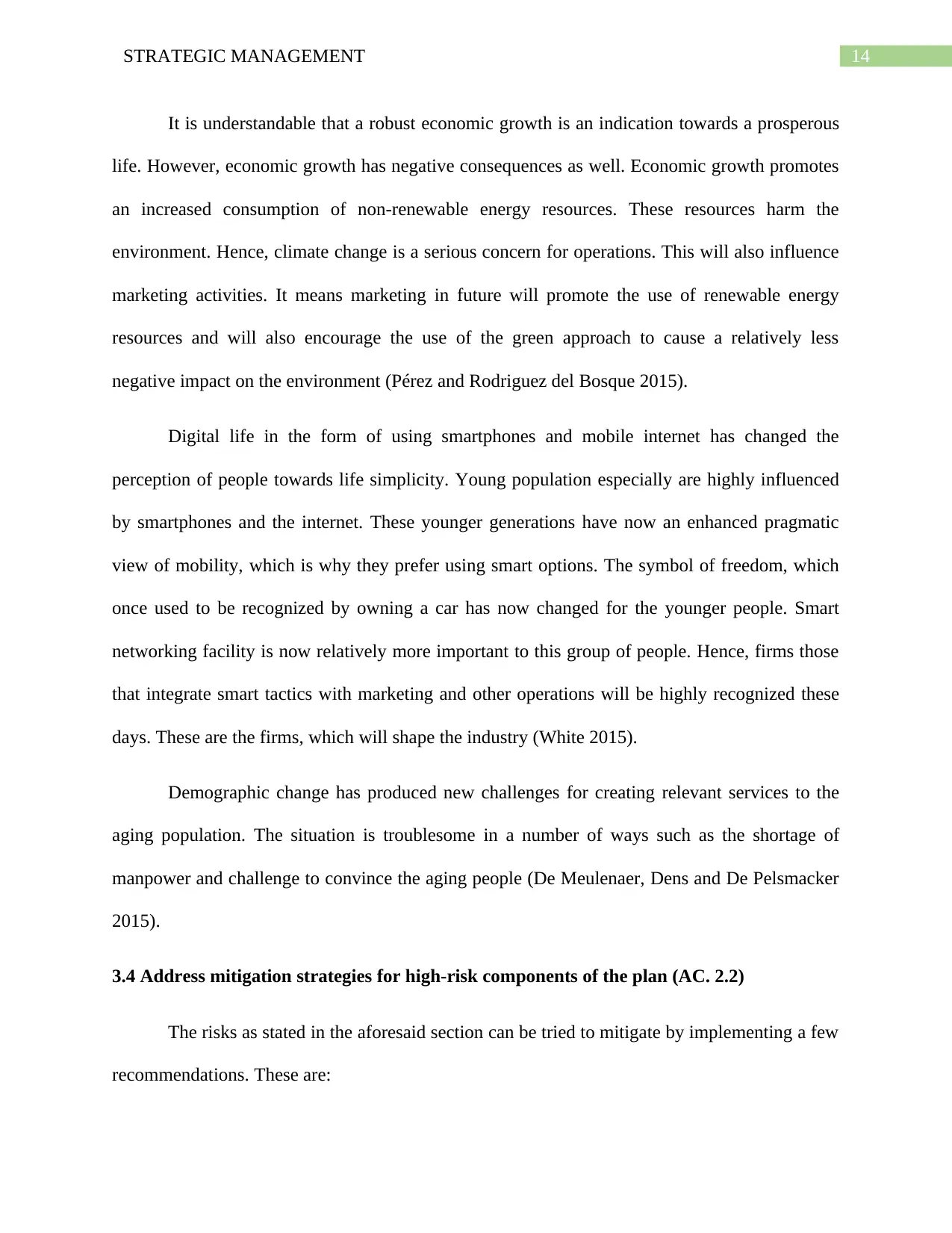
14STRATEGIC MANAGEMENT
It is understandable that a robust economic growth is an indication towards a prosperous
life. However, economic growth has negative consequences as well. Economic growth promotes
an increased consumption of non-renewable energy resources. These resources harm the
environment. Hence, climate change is a serious concern for operations. This will also influence
marketing activities. It means marketing in future will promote the use of renewable energy
resources and will also encourage the use of the green approach to cause a relatively less
negative impact on the environment (Pérez and Rodriguez del Bosque 2015).
Digital life in the form of using smartphones and mobile internet has changed the
perception of people towards life simplicity. Young population especially are highly influenced
by smartphones and the internet. These younger generations have now an enhanced pragmatic
view of mobility, which is why they prefer using smart options. The symbol of freedom, which
once used to be recognized by owning a car has now changed for the younger people. Smart
networking facility is now relatively more important to this group of people. Hence, firms those
that integrate smart tactics with marketing and other operations will be highly recognized these
days. These are the firms, which will shape the industry (White 2015).
Demographic change has produced new challenges for creating relevant services to the
aging population. The situation is troublesome in a number of ways such as the shortage of
manpower and challenge to convince the aging people (De Meulenaer, Dens and De Pelsmacker
2015).
3.4 Address mitigation strategies for high-risk components of the plan (AC. 2.2)
The risks as stated in the aforesaid section can be tried to mitigate by implementing a few
recommendations. These are:
It is understandable that a robust economic growth is an indication towards a prosperous
life. However, economic growth has negative consequences as well. Economic growth promotes
an increased consumption of non-renewable energy resources. These resources harm the
environment. Hence, climate change is a serious concern for operations. This will also influence
marketing activities. It means marketing in future will promote the use of renewable energy
resources and will also encourage the use of the green approach to cause a relatively less
negative impact on the environment (Pérez and Rodriguez del Bosque 2015).
Digital life in the form of using smartphones and mobile internet has changed the
perception of people towards life simplicity. Young population especially are highly influenced
by smartphones and the internet. These younger generations have now an enhanced pragmatic
view of mobility, which is why they prefer using smart options. The symbol of freedom, which
once used to be recognized by owning a car has now changed for the younger people. Smart
networking facility is now relatively more important to this group of people. Hence, firms those
that integrate smart tactics with marketing and other operations will be highly recognized these
days. These are the firms, which will shape the industry (White 2015).
Demographic change has produced new challenges for creating relevant services to the
aging population. The situation is troublesome in a number of ways such as the shortage of
manpower and challenge to convince the aging people (De Meulenaer, Dens and De Pelsmacker
2015).
3.4 Address mitigation strategies for high-risk components of the plan (AC. 2.2)
The risks as stated in the aforesaid section can be tried to mitigate by implementing a few
recommendations. These are:
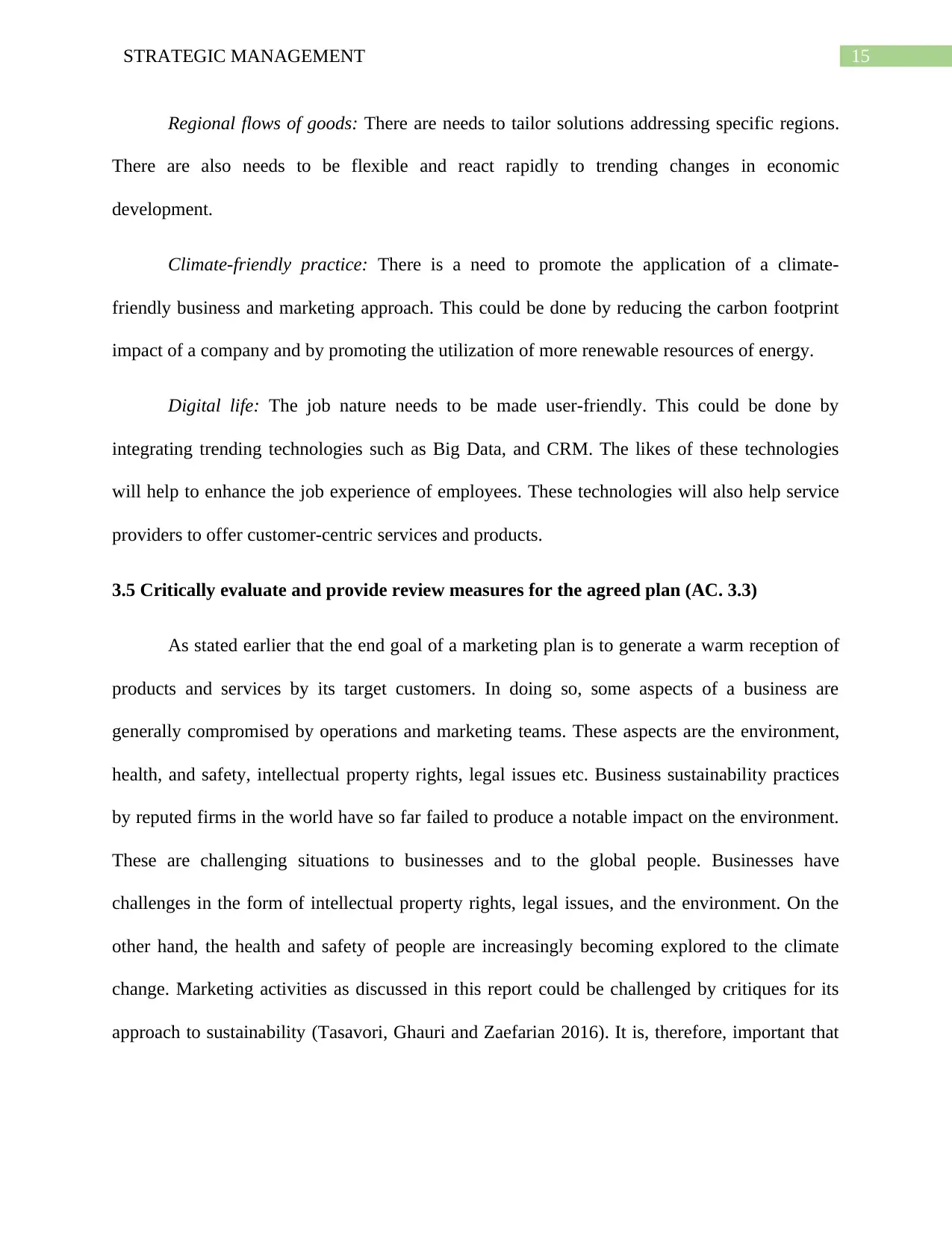
15STRATEGIC MANAGEMENT
Regional flows of goods: There are needs to tailor solutions addressing specific regions.
There are also needs to be flexible and react rapidly to trending changes in economic
development.
Climate-friendly practice: There is a need to promote the application of a climate-
friendly business and marketing approach. This could be done by reducing the carbon footprint
impact of a company and by promoting the utilization of more renewable resources of energy.
Digital life: The job nature needs to be made user-friendly. This could be done by
integrating trending technologies such as Big Data, and CRM. The likes of these technologies
will help to enhance the job experience of employees. These technologies will also help service
providers to offer customer-centric services and products.
3.5 Critically evaluate and provide review measures for the agreed plan (AC. 3.3)
As stated earlier that the end goal of a marketing plan is to generate a warm reception of
products and services by its target customers. In doing so, some aspects of a business are
generally compromised by operations and marketing teams. These aspects are the environment,
health, and safety, intellectual property rights, legal issues etc. Business sustainability practices
by reputed firms in the world have so far failed to produce a notable impact on the environment.
These are challenging situations to businesses and to the global people. Businesses have
challenges in the form of intellectual property rights, legal issues, and the environment. On the
other hand, the health and safety of people are increasingly becoming explored to the climate
change. Marketing activities as discussed in this report could be challenged by critiques for its
approach to sustainability (Tasavori, Ghauri and Zaefarian 2016). It is, therefore, important that
Regional flows of goods: There are needs to tailor solutions addressing specific regions.
There are also needs to be flexible and react rapidly to trending changes in economic
development.
Climate-friendly practice: There is a need to promote the application of a climate-
friendly business and marketing approach. This could be done by reducing the carbon footprint
impact of a company and by promoting the utilization of more renewable resources of energy.
Digital life: The job nature needs to be made user-friendly. This could be done by
integrating trending technologies such as Big Data, and CRM. The likes of these technologies
will help to enhance the job experience of employees. These technologies will also help service
providers to offer customer-centric services and products.
3.5 Critically evaluate and provide review measures for the agreed plan (AC. 3.3)
As stated earlier that the end goal of a marketing plan is to generate a warm reception of
products and services by its target customers. In doing so, some aspects of a business are
generally compromised by operations and marketing teams. These aspects are the environment,
health, and safety, intellectual property rights, legal issues etc. Business sustainability practices
by reputed firms in the world have so far failed to produce a notable impact on the environment.
These are challenging situations to businesses and to the global people. Businesses have
challenges in the form of intellectual property rights, legal issues, and the environment. On the
other hand, the health and safety of people are increasingly becoming explored to the climate
change. Marketing activities as discussed in this report could be challenged by critiques for its
approach to sustainability (Tasavori, Ghauri and Zaefarian 2016). It is, therefore, important that
Paraphrase This Document
Need a fresh take? Get an instant paraphrase of this document with our AI Paraphraser
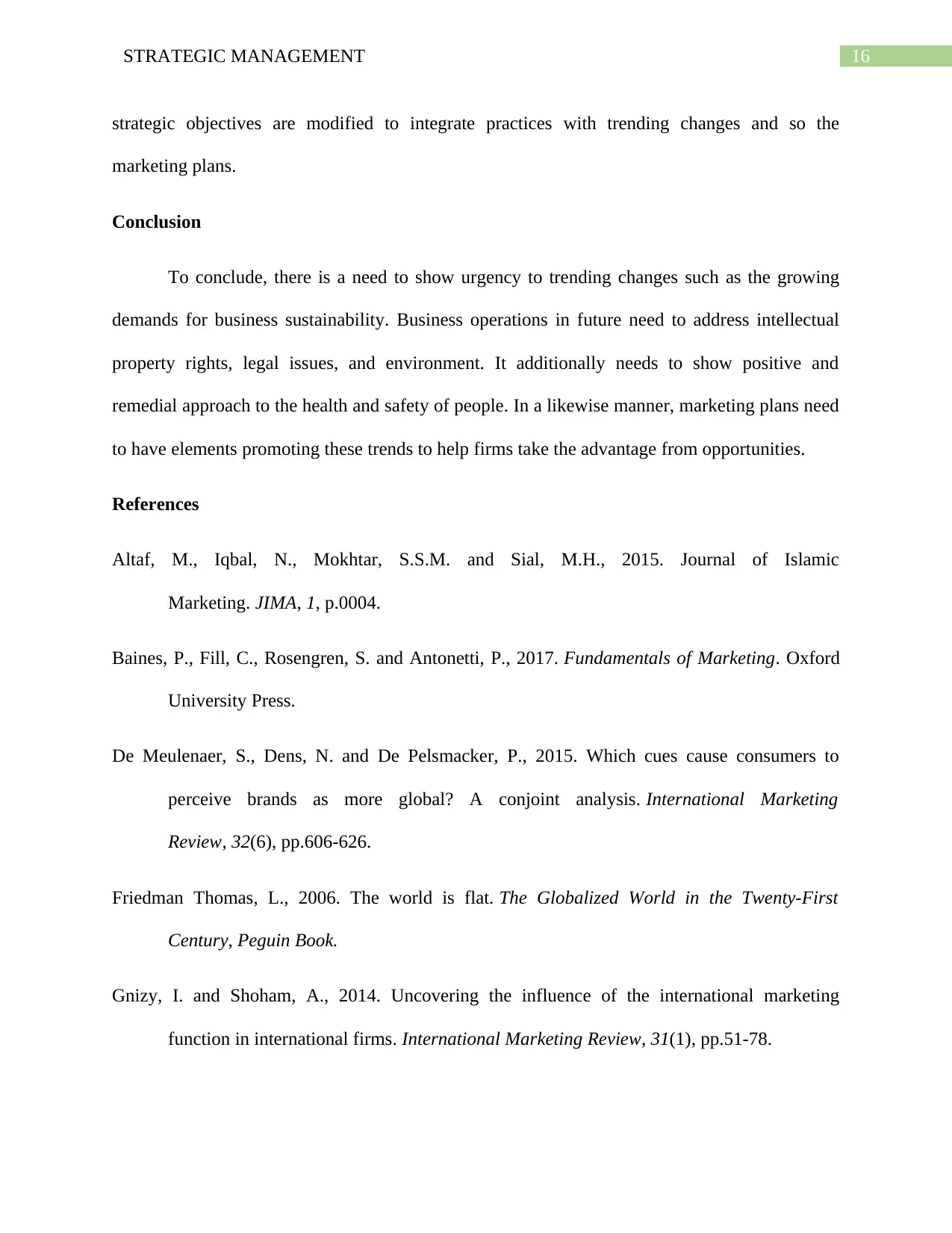
16STRATEGIC MANAGEMENT
strategic objectives are modified to integrate practices with trending changes and so the
marketing plans.
Conclusion
To conclude, there is a need to show urgency to trending changes such as the growing
demands for business sustainability. Business operations in future need to address intellectual
property rights, legal issues, and environment. It additionally needs to show positive and
remedial approach to the health and safety of people. In a likewise manner, marketing plans need
to have elements promoting these trends to help firms take the advantage from opportunities.
References
Altaf, M., Iqbal, N., Mokhtar, S.S.M. and Sial, M.H., 2015. Journal of Islamic
Marketing. JIMA, 1, p.0004.
Baines, P., Fill, C., Rosengren, S. and Antonetti, P., 2017. Fundamentals of Marketing. Oxford
University Press.
De Meulenaer, S., Dens, N. and De Pelsmacker, P., 2015. Which cues cause consumers to
perceive brands as more global? A conjoint analysis. International Marketing
Review, 32(6), pp.606-626.
Friedman Thomas, L., 2006. The world is flat. The Globalized World in the Twenty-First
Century, Peguin Book.
Gnizy, I. and Shoham, A., 2014. Uncovering the influence of the international marketing
function in international firms. International Marketing Review, 31(1), pp.51-78.
strategic objectives are modified to integrate practices with trending changes and so the
marketing plans.
Conclusion
To conclude, there is a need to show urgency to trending changes such as the growing
demands for business sustainability. Business operations in future need to address intellectual
property rights, legal issues, and environment. It additionally needs to show positive and
remedial approach to the health and safety of people. In a likewise manner, marketing plans need
to have elements promoting these trends to help firms take the advantage from opportunities.
References
Altaf, M., Iqbal, N., Mokhtar, S.S.M. and Sial, M.H., 2015. Journal of Islamic
Marketing. JIMA, 1, p.0004.
Baines, P., Fill, C., Rosengren, S. and Antonetti, P., 2017. Fundamentals of Marketing. Oxford
University Press.
De Meulenaer, S., Dens, N. and De Pelsmacker, P., 2015. Which cues cause consumers to
perceive brands as more global? A conjoint analysis. International Marketing
Review, 32(6), pp.606-626.
Friedman Thomas, L., 2006. The world is flat. The Globalized World in the Twenty-First
Century, Peguin Book.
Gnizy, I. and Shoham, A., 2014. Uncovering the influence of the international marketing
function in international firms. International Marketing Review, 31(1), pp.51-78.
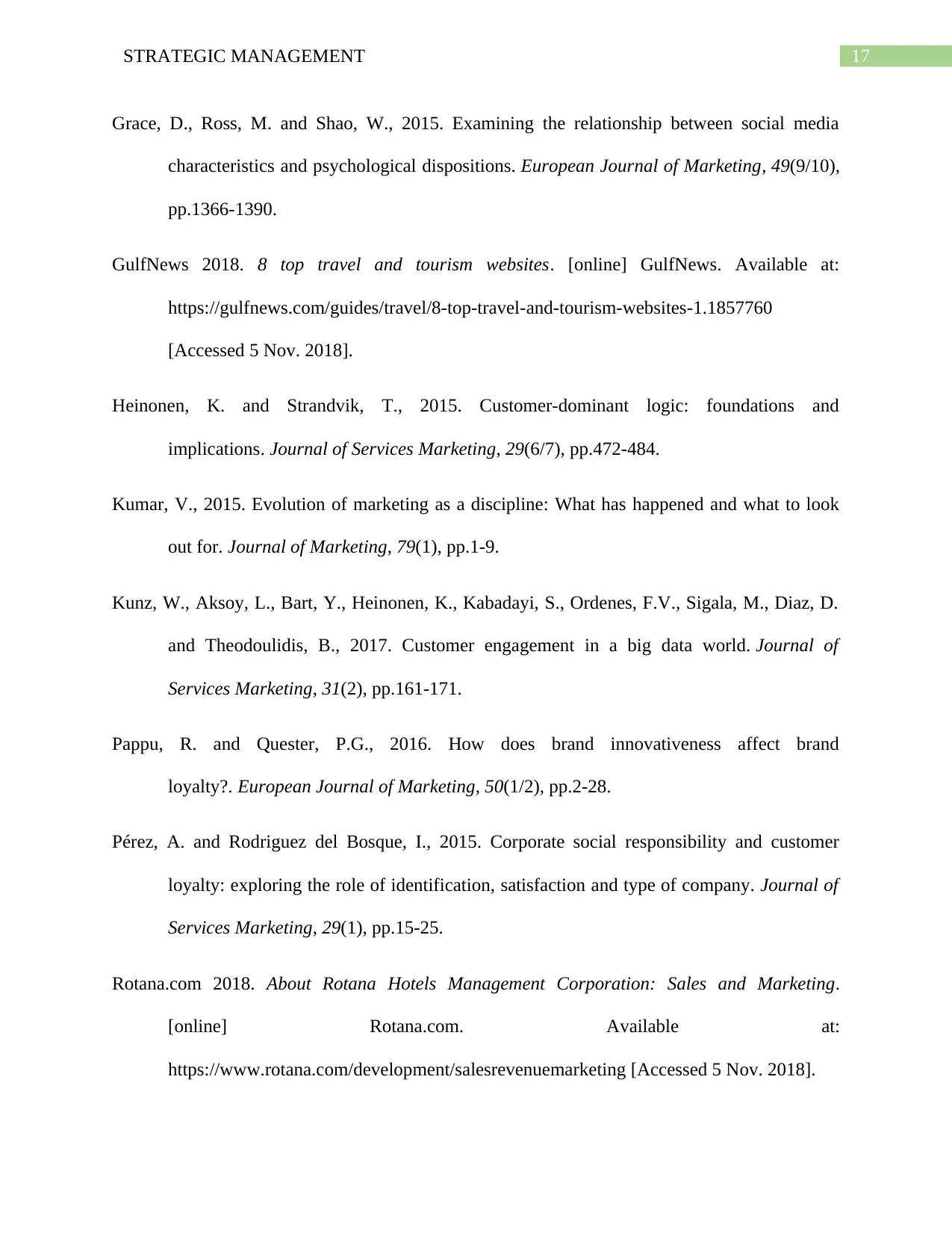
17STRATEGIC MANAGEMENT
Grace, D., Ross, M. and Shao, W., 2015. Examining the relationship between social media
characteristics and psychological dispositions. European Journal of Marketing, 49(9/10),
pp.1366-1390.
GulfNews 2018. 8 top travel and tourism websites. [online] GulfNews. Available at:
https://gulfnews.com/guides/travel/8-top-travel-and-tourism-websites-1.1857760
[Accessed 5 Nov. 2018].
Heinonen, K. and Strandvik, T., 2015. Customer-dominant logic: foundations and
implications. Journal of Services Marketing, 29(6/7), pp.472-484.
Kumar, V., 2015. Evolution of marketing as a discipline: What has happened and what to look
out for. Journal of Marketing, 79(1), pp.1-9.
Kunz, W., Aksoy, L., Bart, Y., Heinonen, K., Kabadayi, S., Ordenes, F.V., Sigala, M., Diaz, D.
and Theodoulidis, B., 2017. Customer engagement in a big data world. Journal of
Services Marketing, 31(2), pp.161-171.
Pappu, R. and Quester, P.G., 2016. How does brand innovativeness affect brand
loyalty?. European Journal of Marketing, 50(1/2), pp.2-28.
Pérez, A. and Rodriguez del Bosque, I., 2015. Corporate social responsibility and customer
loyalty: exploring the role of identification, satisfaction and type of company. Journal of
Services Marketing, 29(1), pp.15-25.
Rotana.com 2018. About Rotana Hotels Management Corporation: Sales and Marketing.
[online] Rotana.com. Available at:
https://www.rotana.com/development/salesrevenuemarketing [Accessed 5 Nov. 2018].
Grace, D., Ross, M. and Shao, W., 2015. Examining the relationship between social media
characteristics and psychological dispositions. European Journal of Marketing, 49(9/10),
pp.1366-1390.
GulfNews 2018. 8 top travel and tourism websites. [online] GulfNews. Available at:
https://gulfnews.com/guides/travel/8-top-travel-and-tourism-websites-1.1857760
[Accessed 5 Nov. 2018].
Heinonen, K. and Strandvik, T., 2015. Customer-dominant logic: foundations and
implications. Journal of Services Marketing, 29(6/7), pp.472-484.
Kumar, V., 2015. Evolution of marketing as a discipline: What has happened and what to look
out for. Journal of Marketing, 79(1), pp.1-9.
Kunz, W., Aksoy, L., Bart, Y., Heinonen, K., Kabadayi, S., Ordenes, F.V., Sigala, M., Diaz, D.
and Theodoulidis, B., 2017. Customer engagement in a big data world. Journal of
Services Marketing, 31(2), pp.161-171.
Pappu, R. and Quester, P.G., 2016. How does brand innovativeness affect brand
loyalty?. European Journal of Marketing, 50(1/2), pp.2-28.
Pérez, A. and Rodriguez del Bosque, I., 2015. Corporate social responsibility and customer
loyalty: exploring the role of identification, satisfaction and type of company. Journal of
Services Marketing, 29(1), pp.15-25.
Rotana.com 2018. About Rotana Hotels Management Corporation: Sales and Marketing.
[online] Rotana.com. Available at:
https://www.rotana.com/development/salesrevenuemarketing [Accessed 5 Nov. 2018].

18STRATEGIC MANAGEMENT
Rotana.com. 2018. Retrieved from https://www.rotana.com/aboutrotana/rotanavalues
Tasavori, M., Ghauri, P.N. and Zaefarian, R., 2016. Entering the base of the pyramid market in
India: A corporate social entrepreneurship perspective. International Marketing
Review, 33(4), pp.555-579.
Tr.rotana.com 2018. Sales & Marketing, Development. [online] Tr.rotana.com. Available at:
https://tr.rotana.com/development/salesmarketing [Accessed 5 Nov. 2018].
Viktoria Rampl, L. and Kenning, P., 2014. Employer brand trust and affect: linking brand
personality to employer brand attractiveness. European Journal of Marketing, 48(1/2),
pp.218-236.
White, C., 2015. The impact of motivation on customer satisfaction formation: a self-
determination perspective. European Journal of Marketing, 49(11/12), pp.1923-1940.
Rotana.com. 2018. Retrieved from https://www.rotana.com/aboutrotana/rotanavalues
Tasavori, M., Ghauri, P.N. and Zaefarian, R., 2016. Entering the base of the pyramid market in
India: A corporate social entrepreneurship perspective. International Marketing
Review, 33(4), pp.555-579.
Tr.rotana.com 2018. Sales & Marketing, Development. [online] Tr.rotana.com. Available at:
https://tr.rotana.com/development/salesmarketing [Accessed 5 Nov. 2018].
Viktoria Rampl, L. and Kenning, P., 2014. Employer brand trust and affect: linking brand
personality to employer brand attractiveness. European Journal of Marketing, 48(1/2),
pp.218-236.
White, C., 2015. The impact of motivation on customer satisfaction formation: a self-
determination perspective. European Journal of Marketing, 49(11/12), pp.1923-1940.
1 out of 19
Related Documents
Your All-in-One AI-Powered Toolkit for Academic Success.
+13062052269
info@desklib.com
Available 24*7 on WhatsApp / Email
![[object Object]](/_next/static/media/star-bottom.7253800d.svg)
Unlock your academic potential
© 2024 | Zucol Services PVT LTD | All rights reserved.





